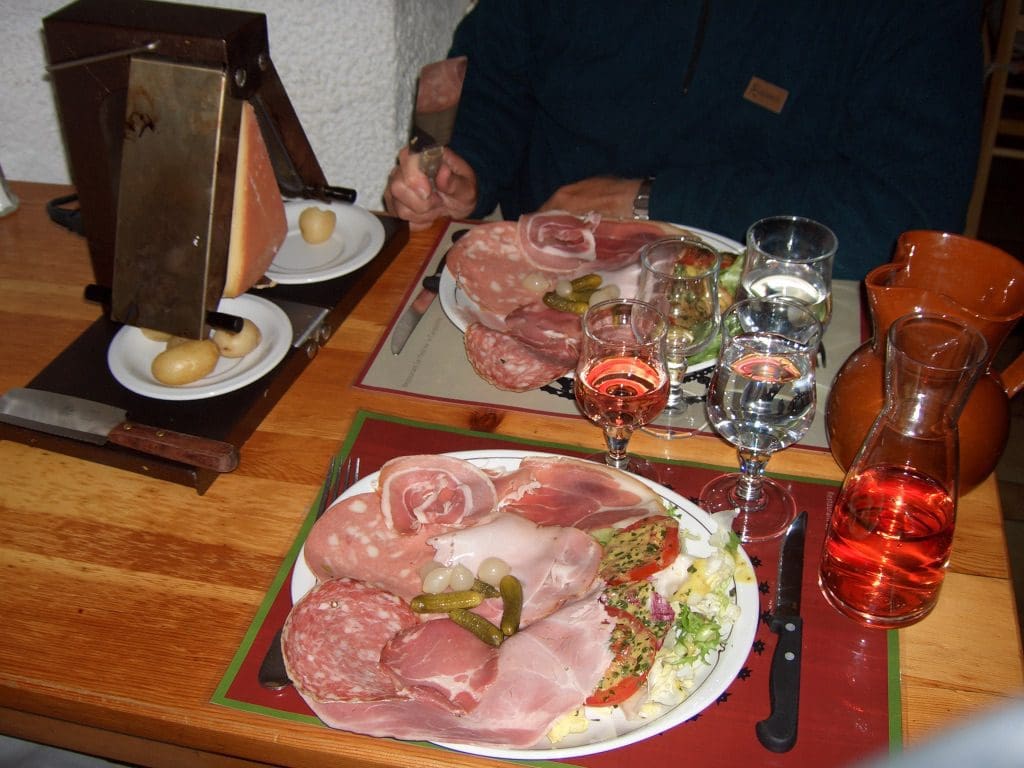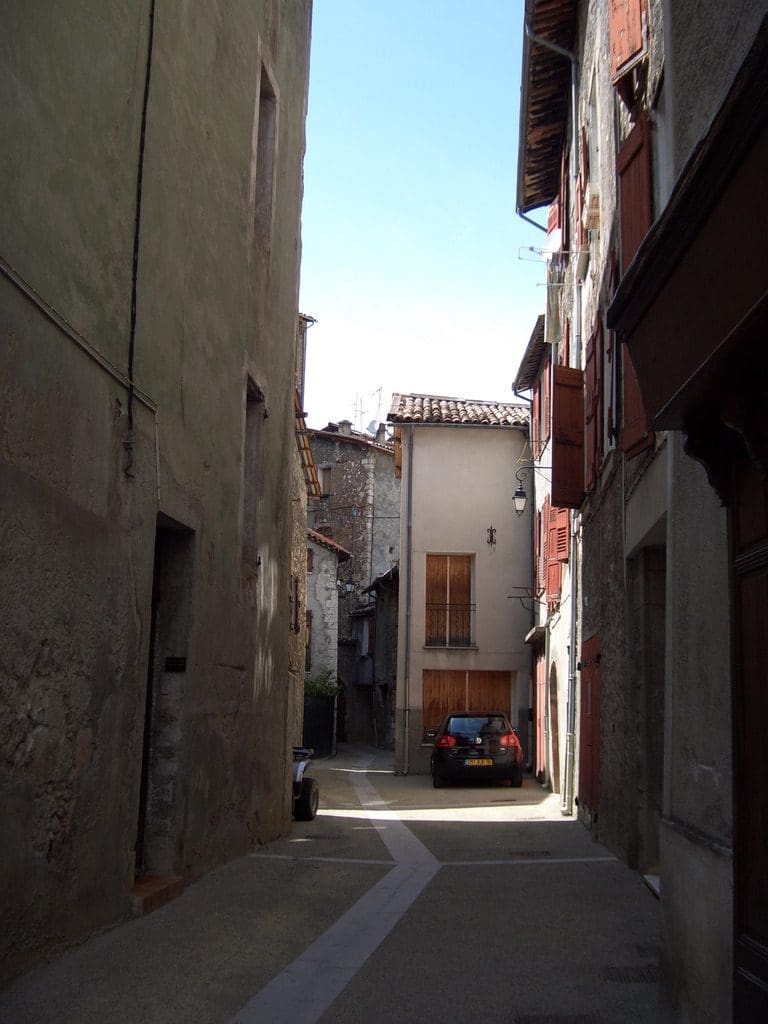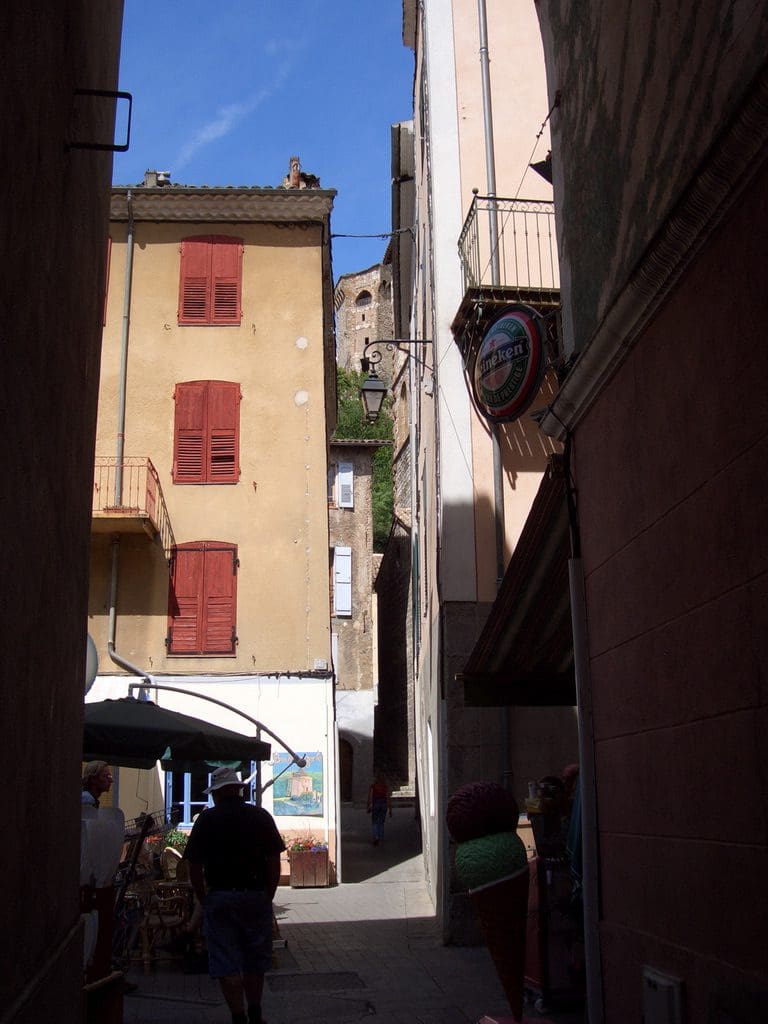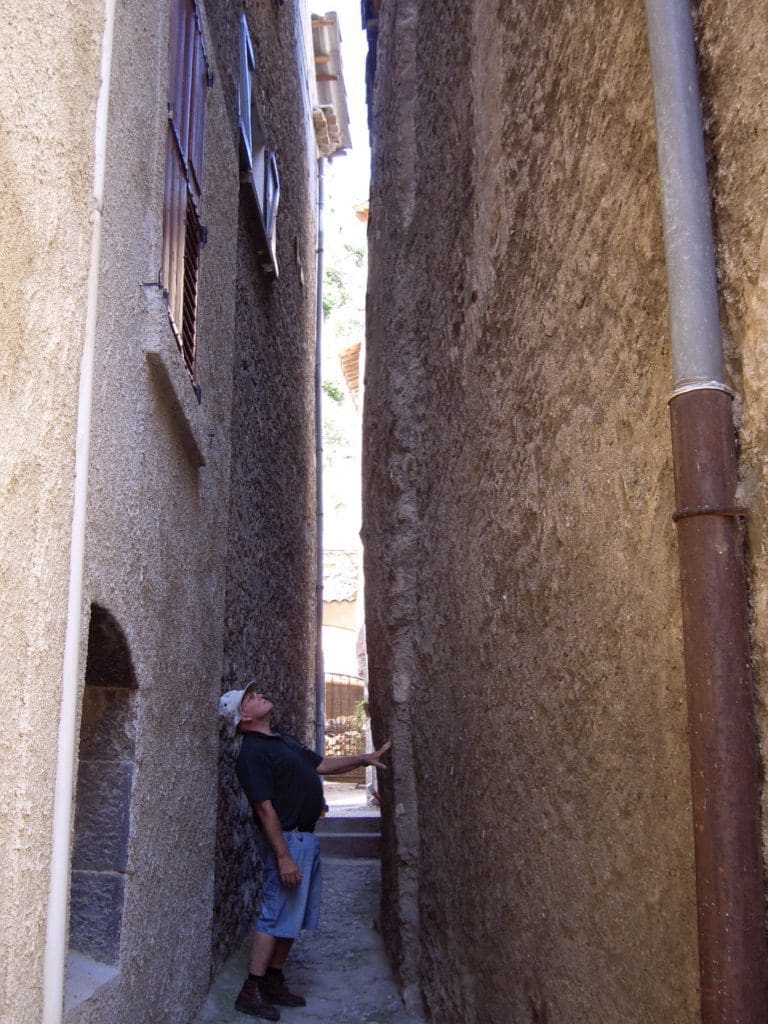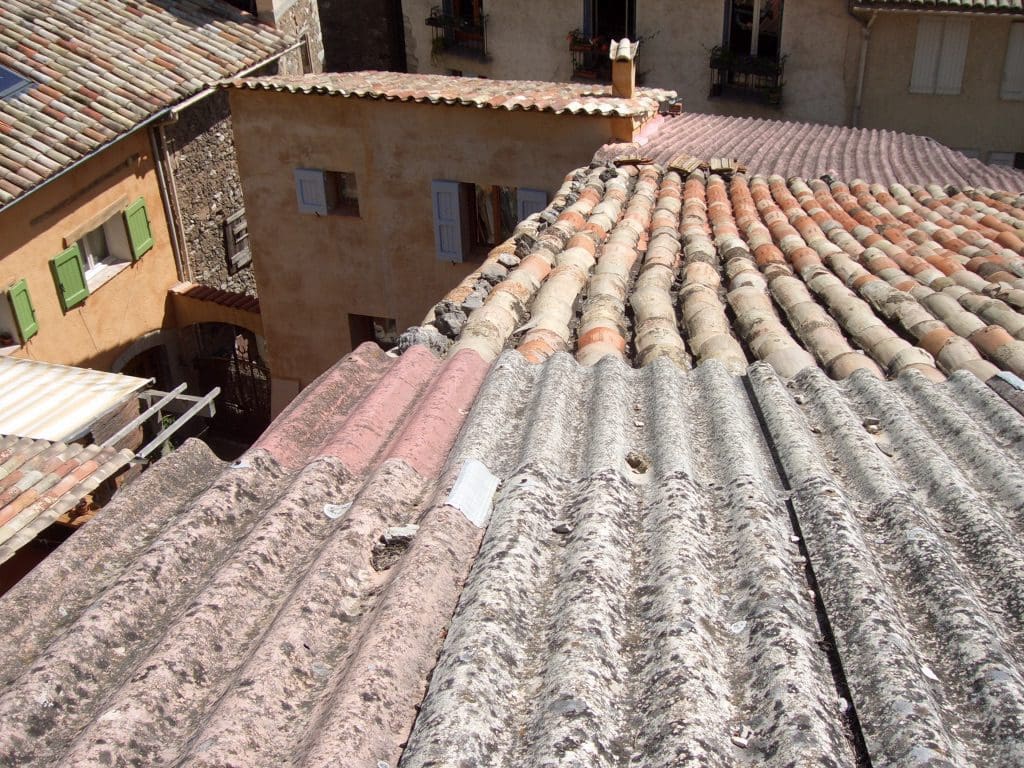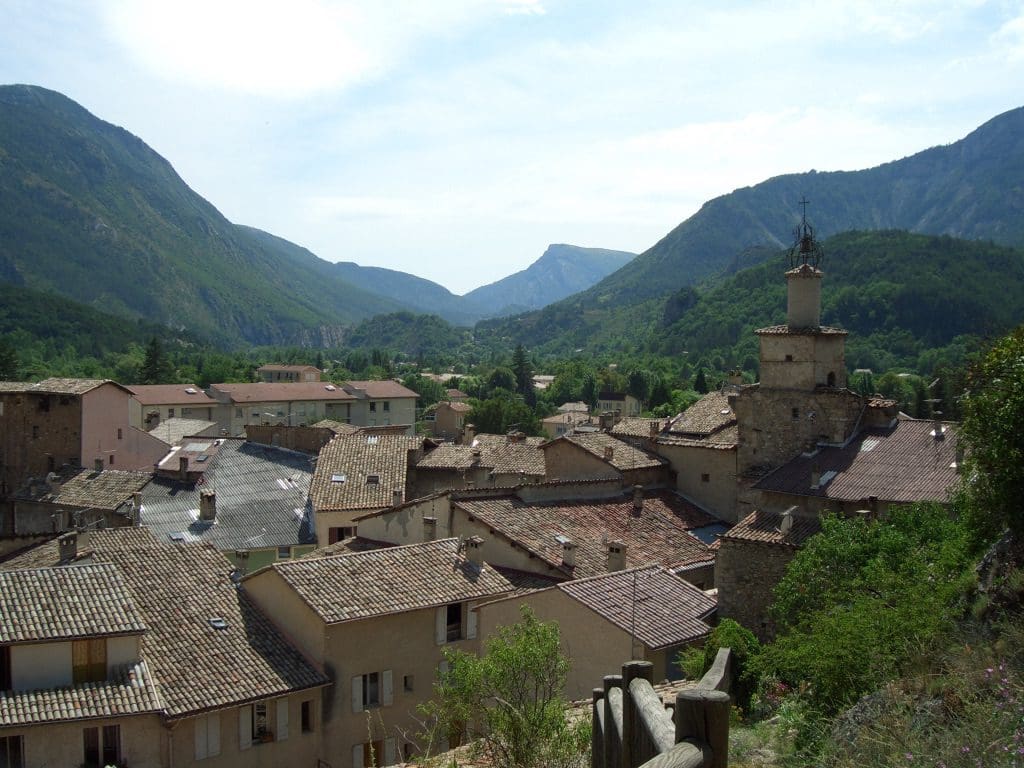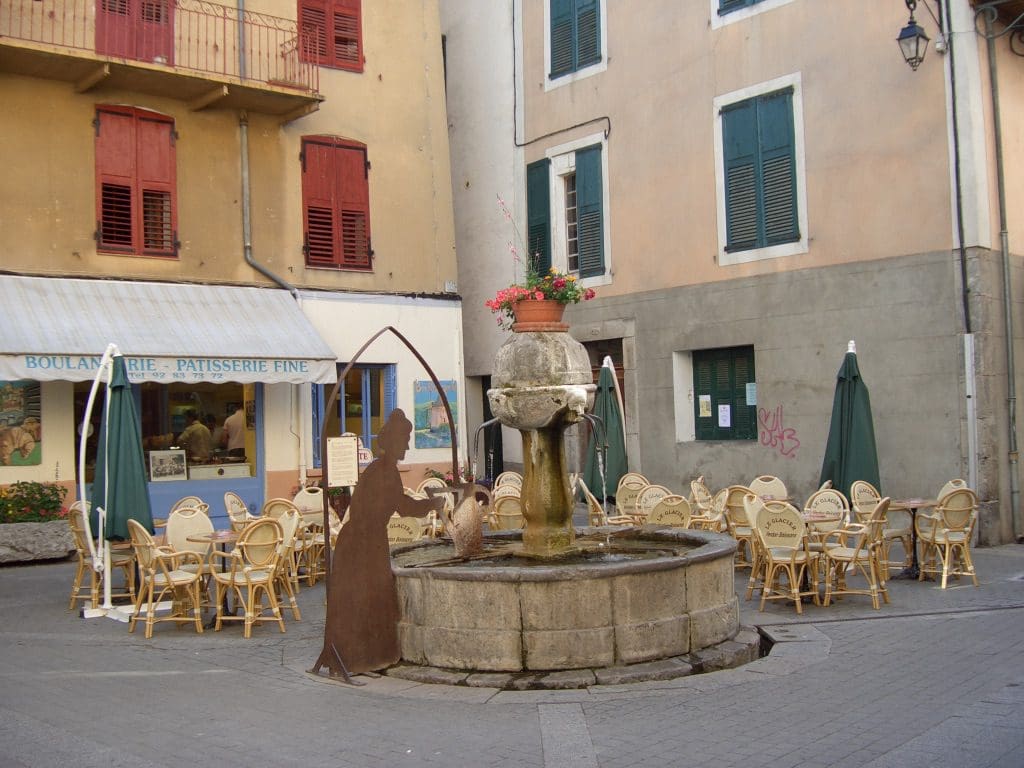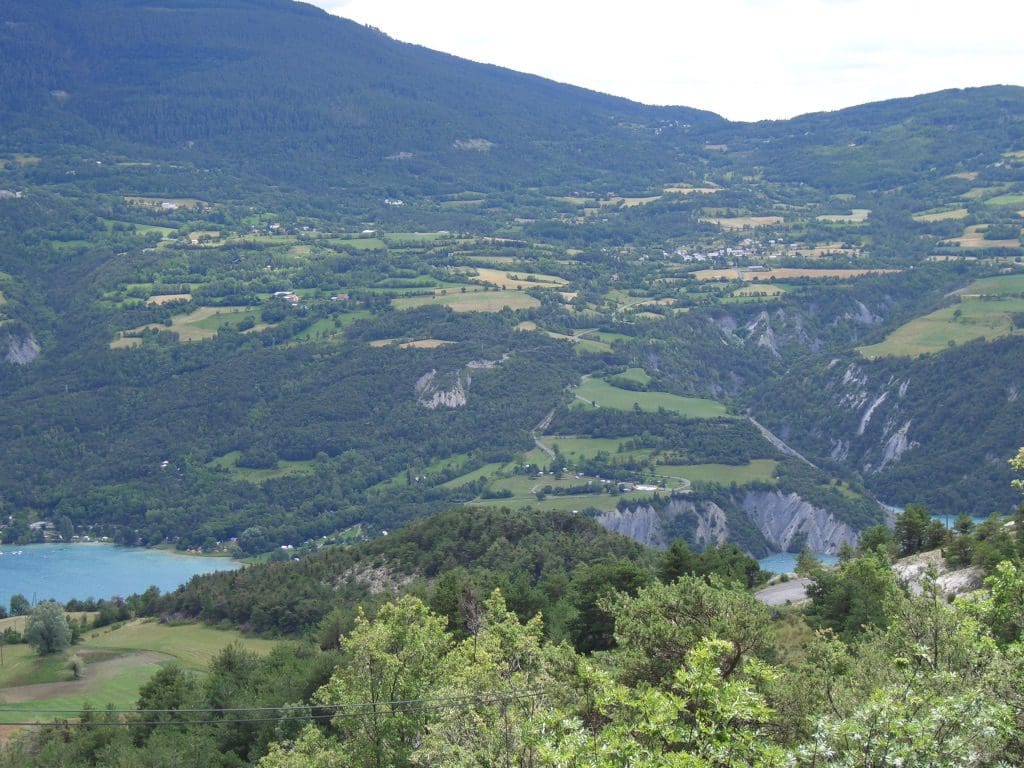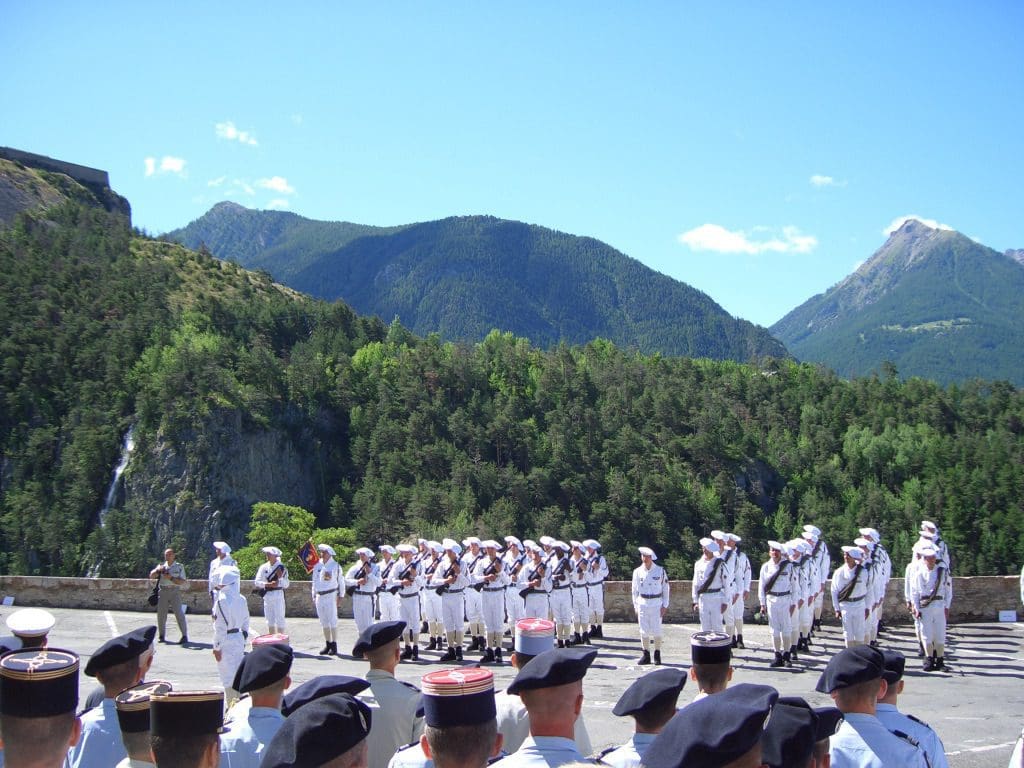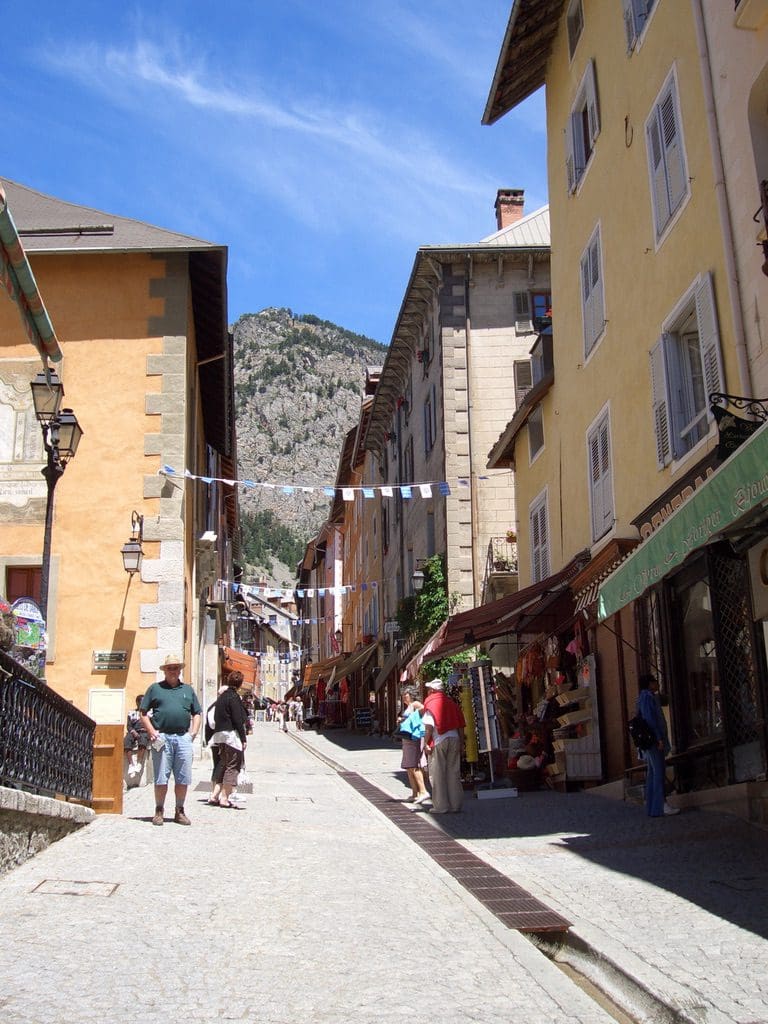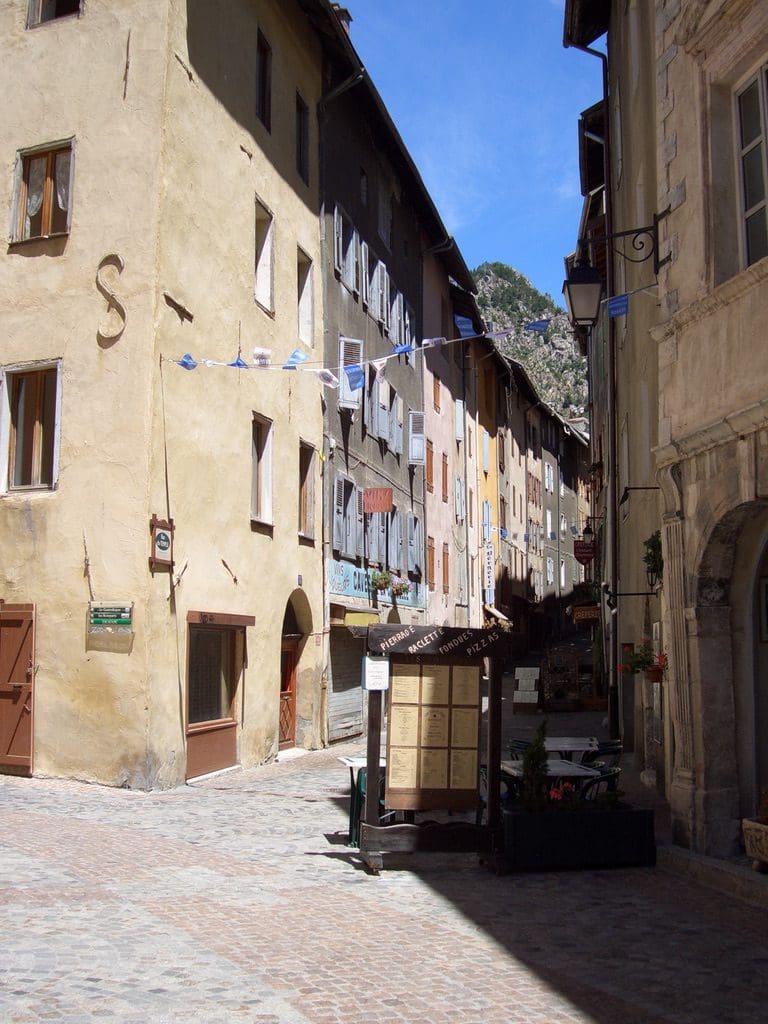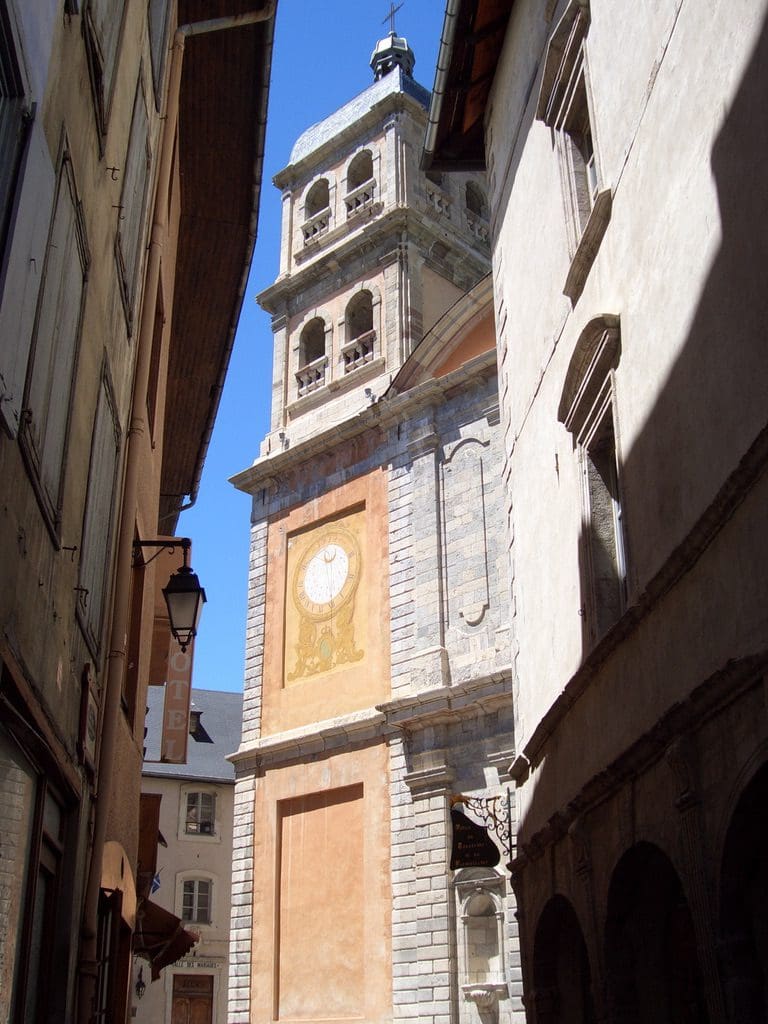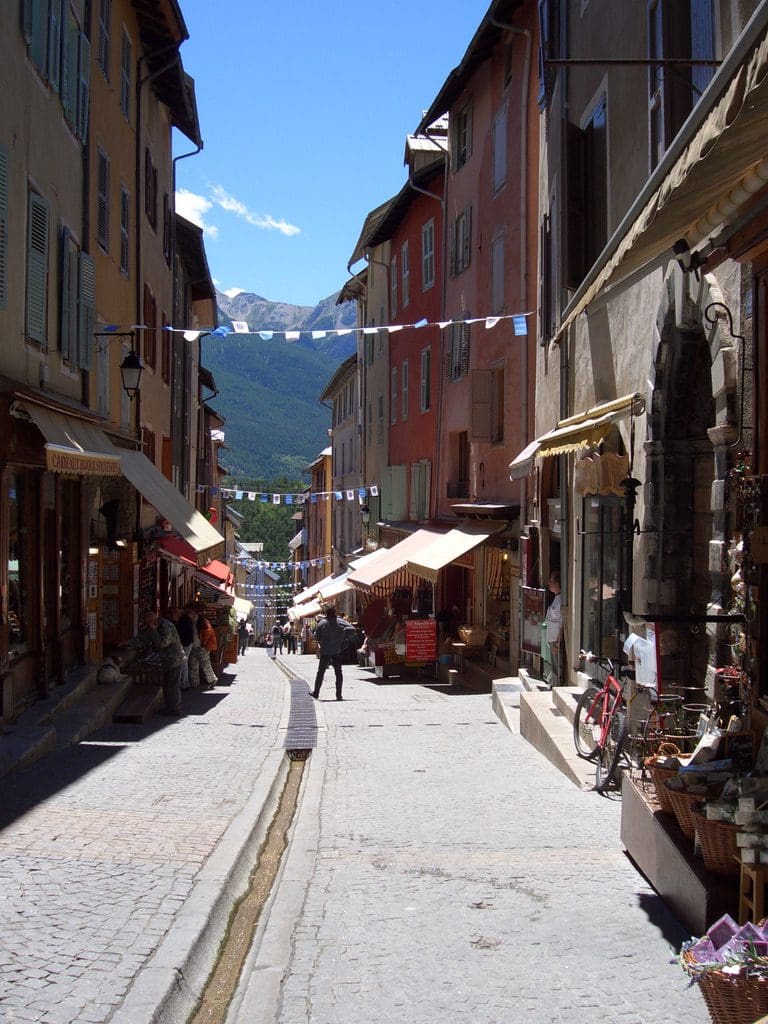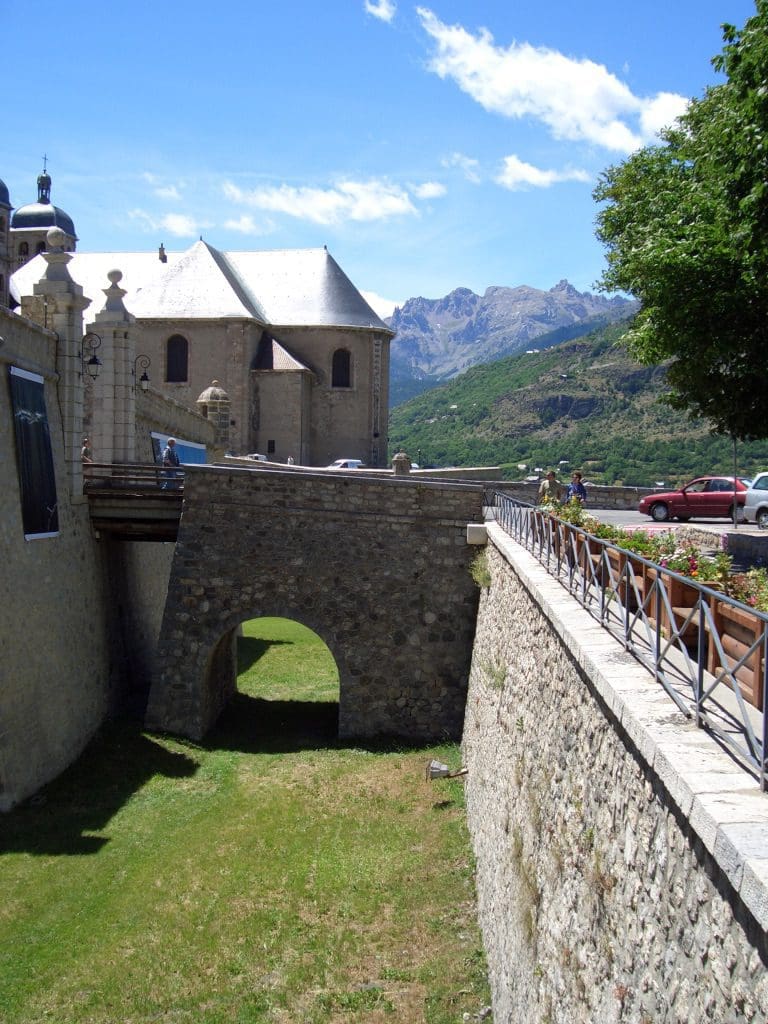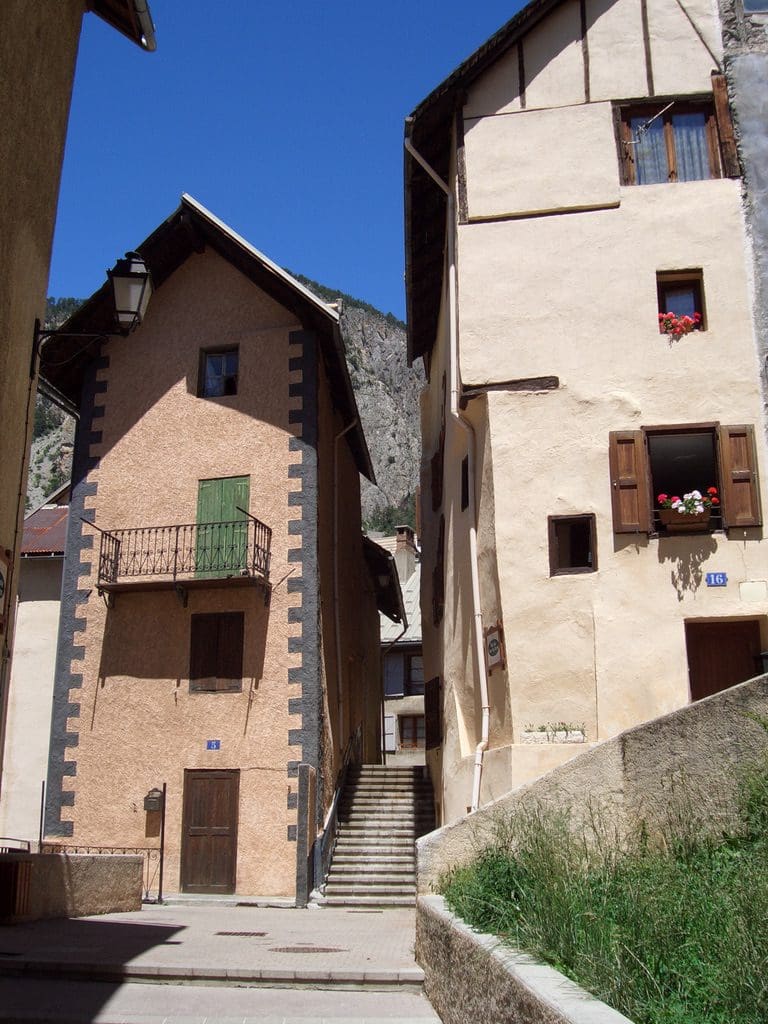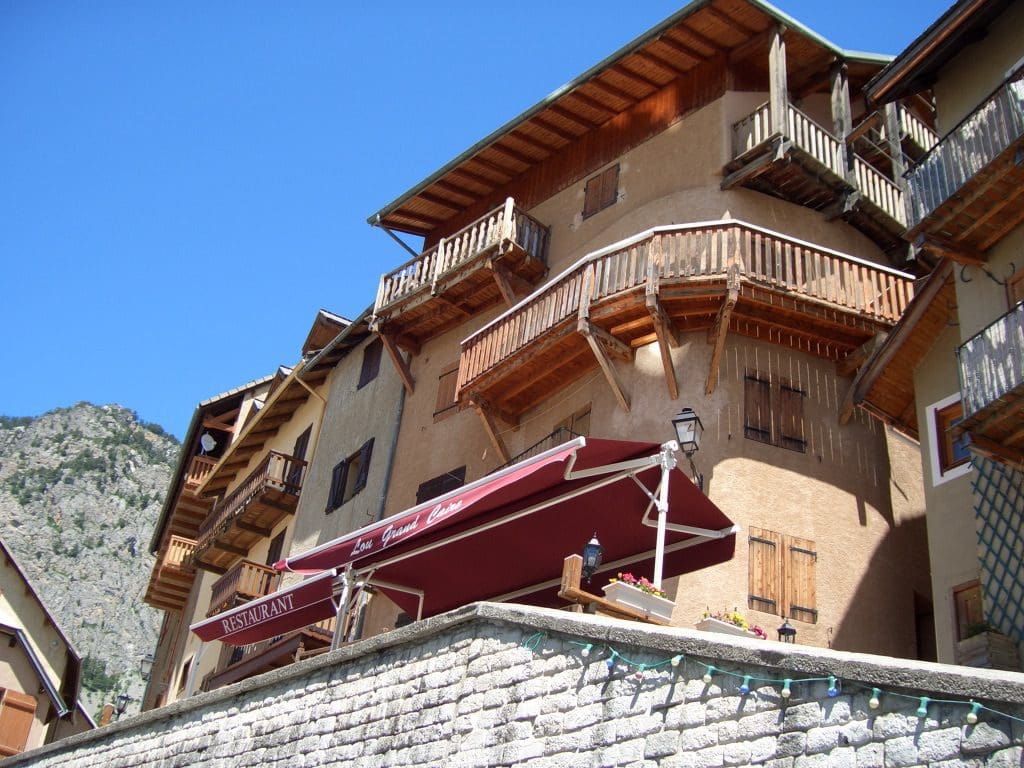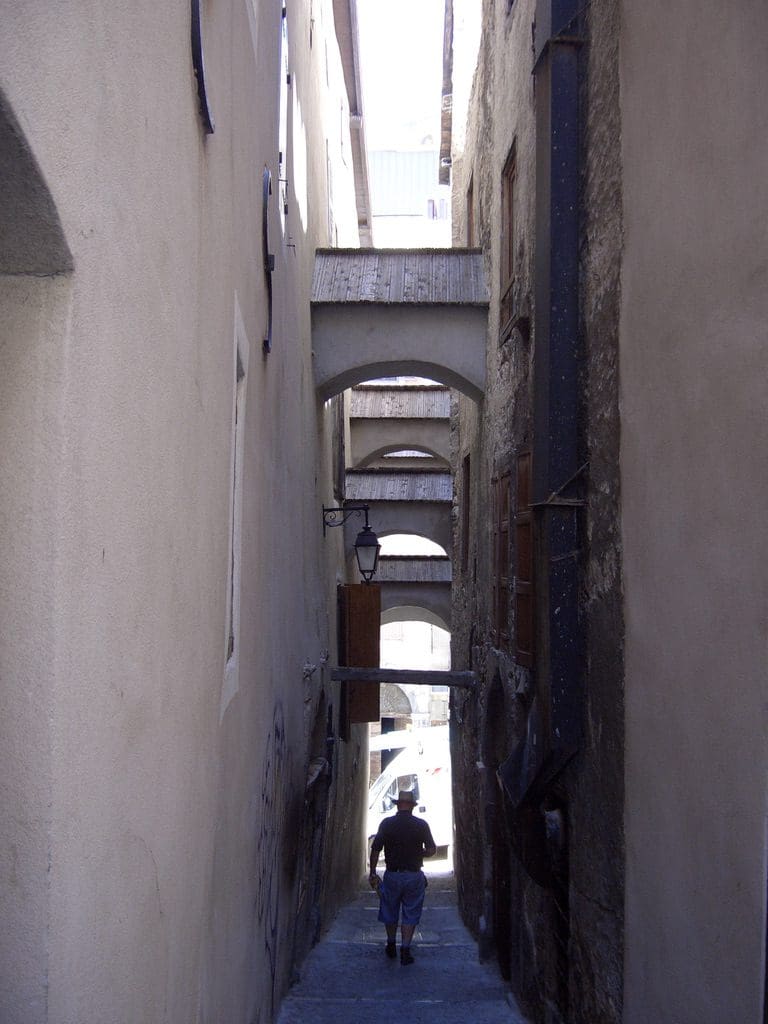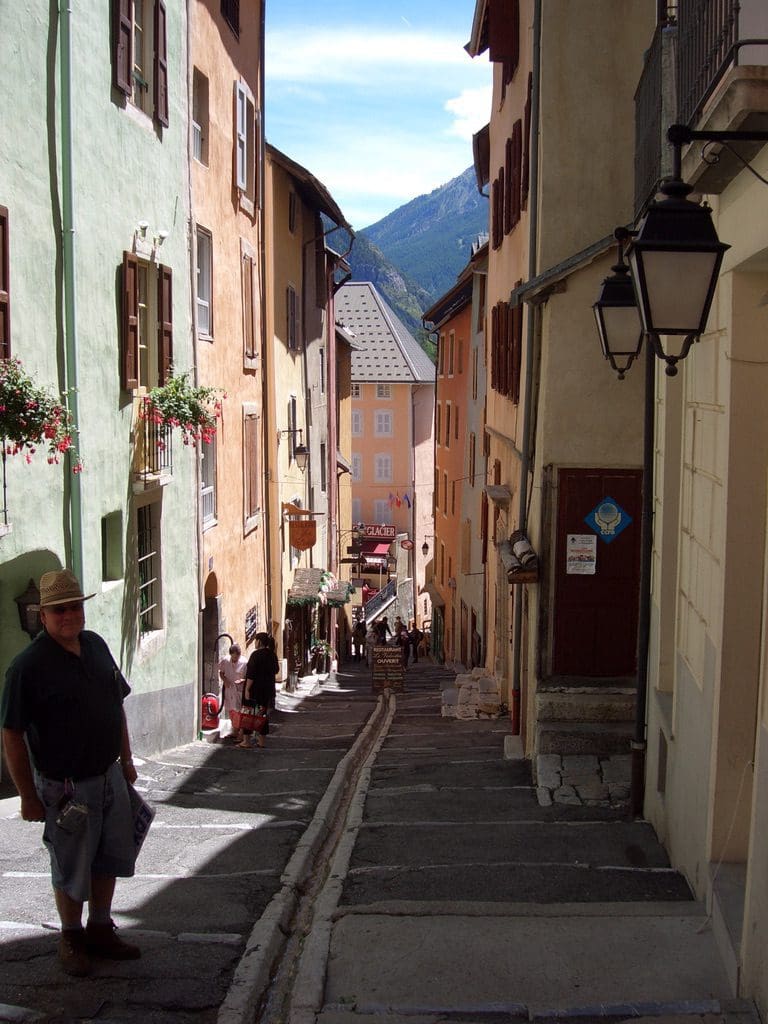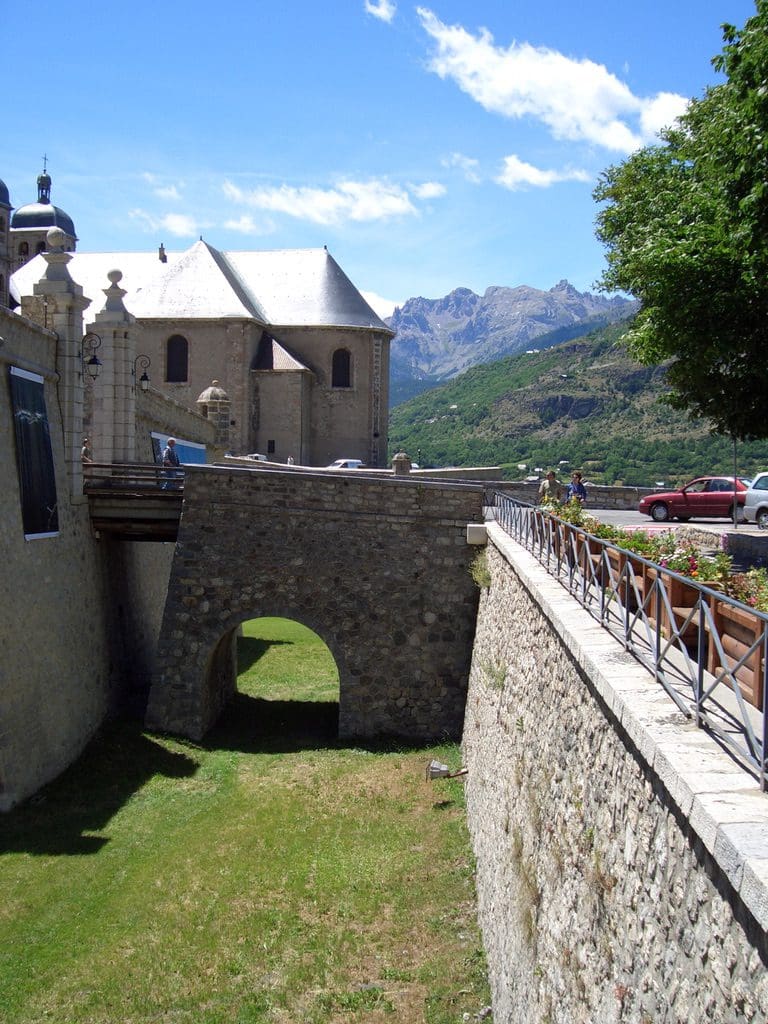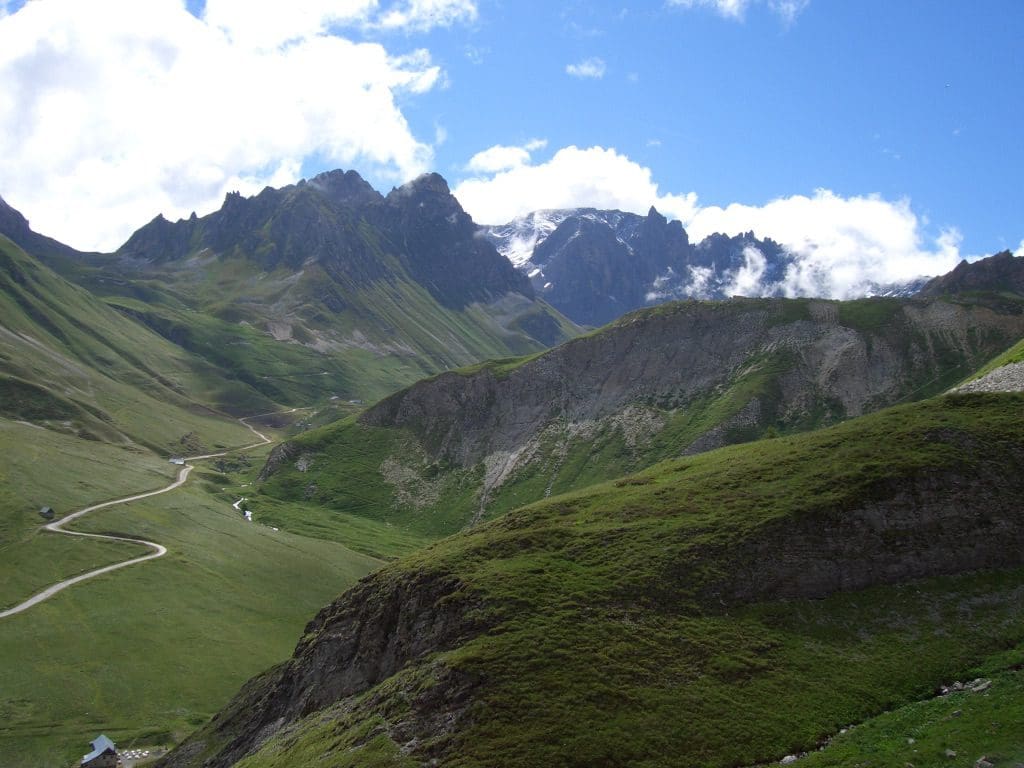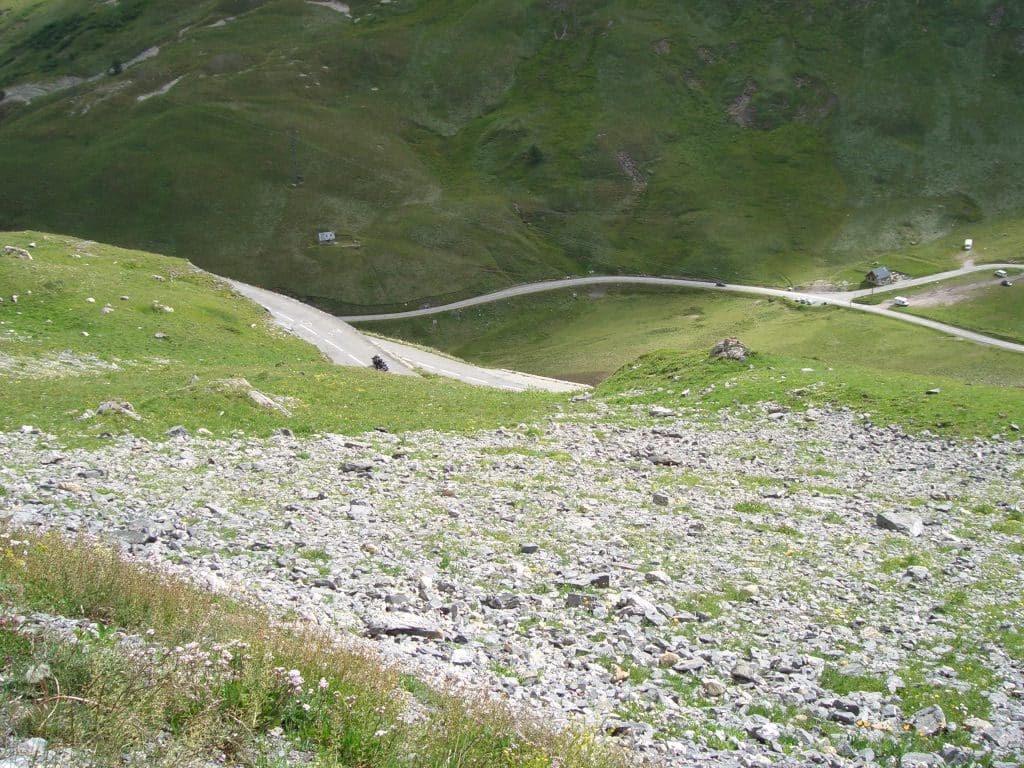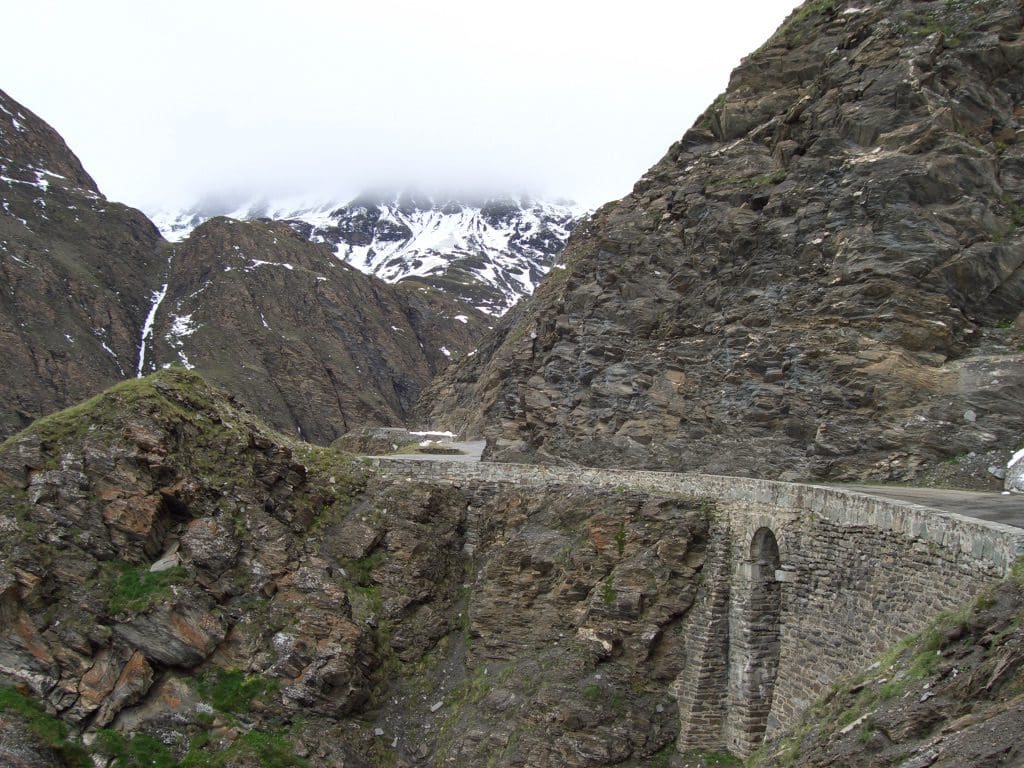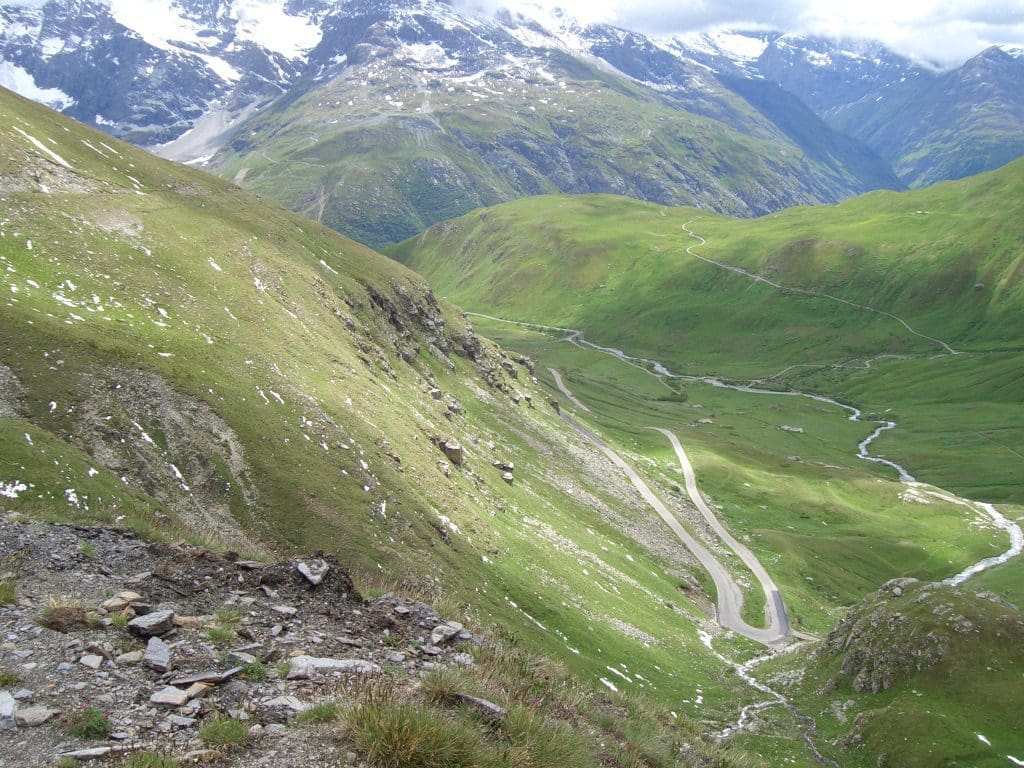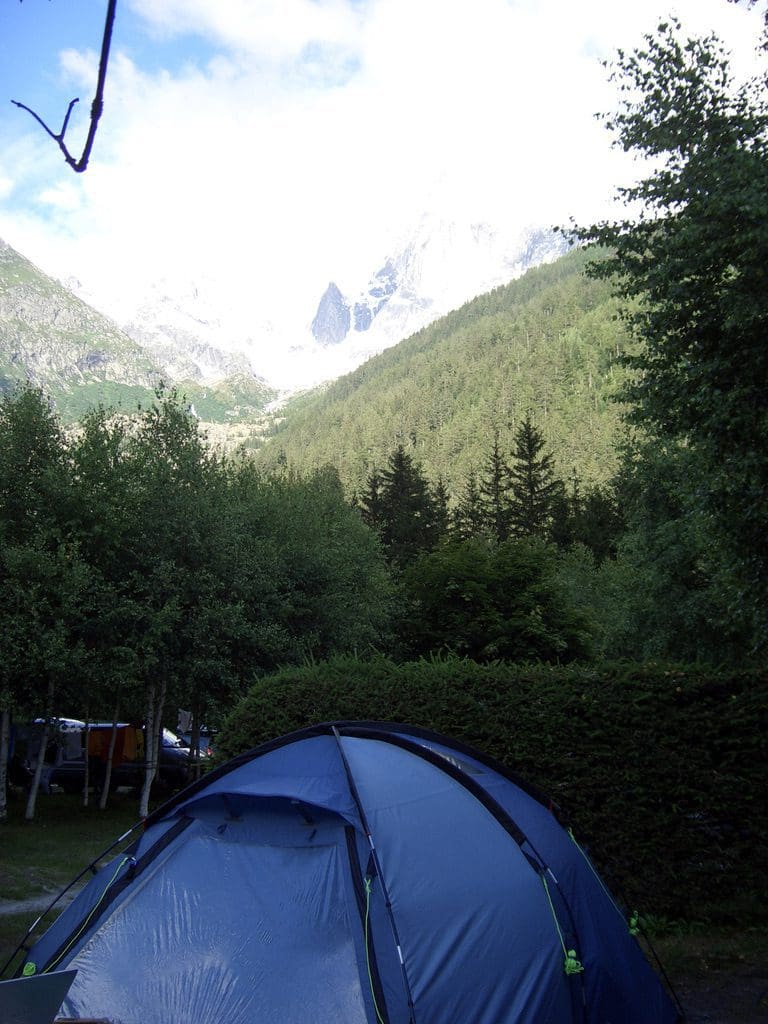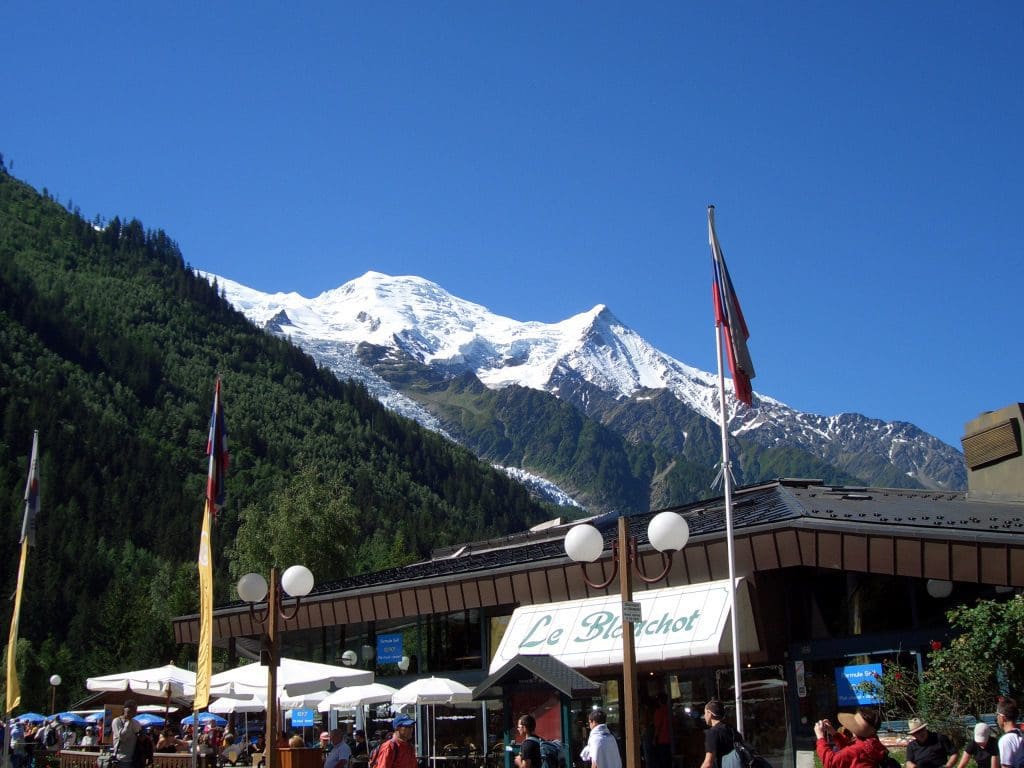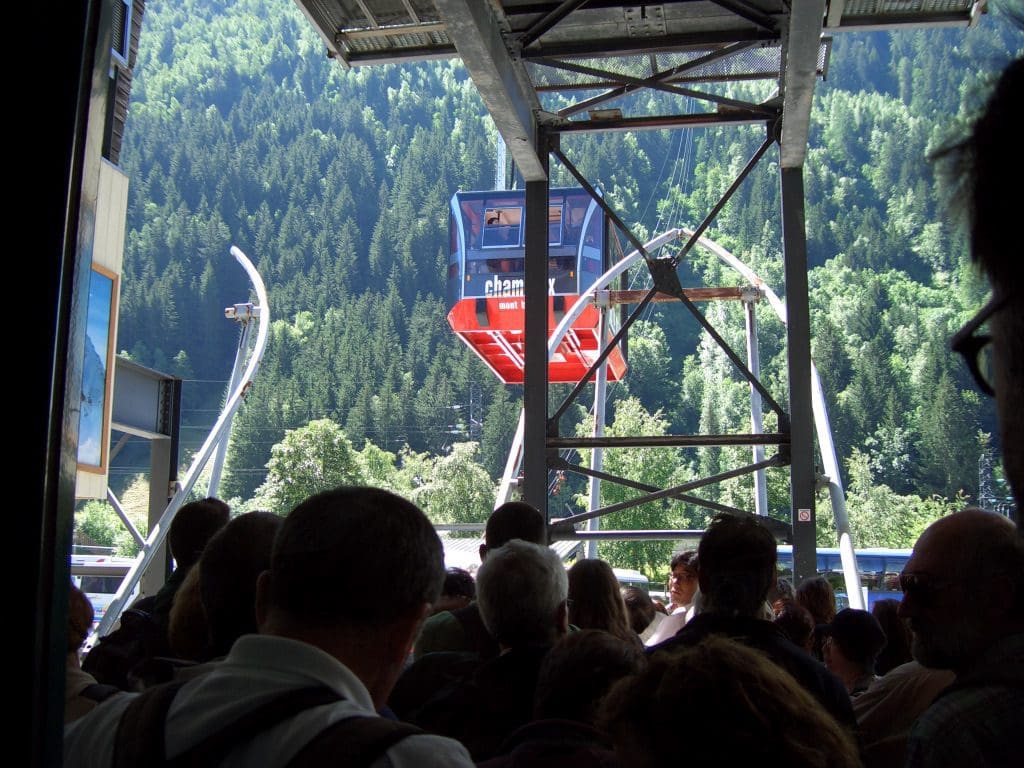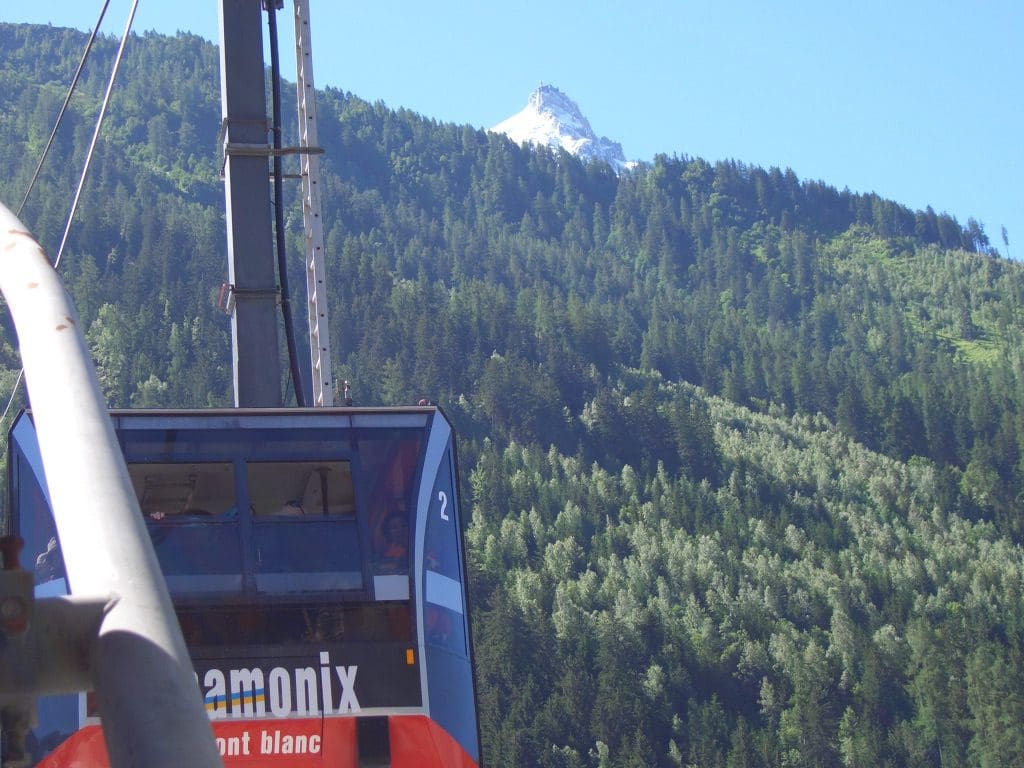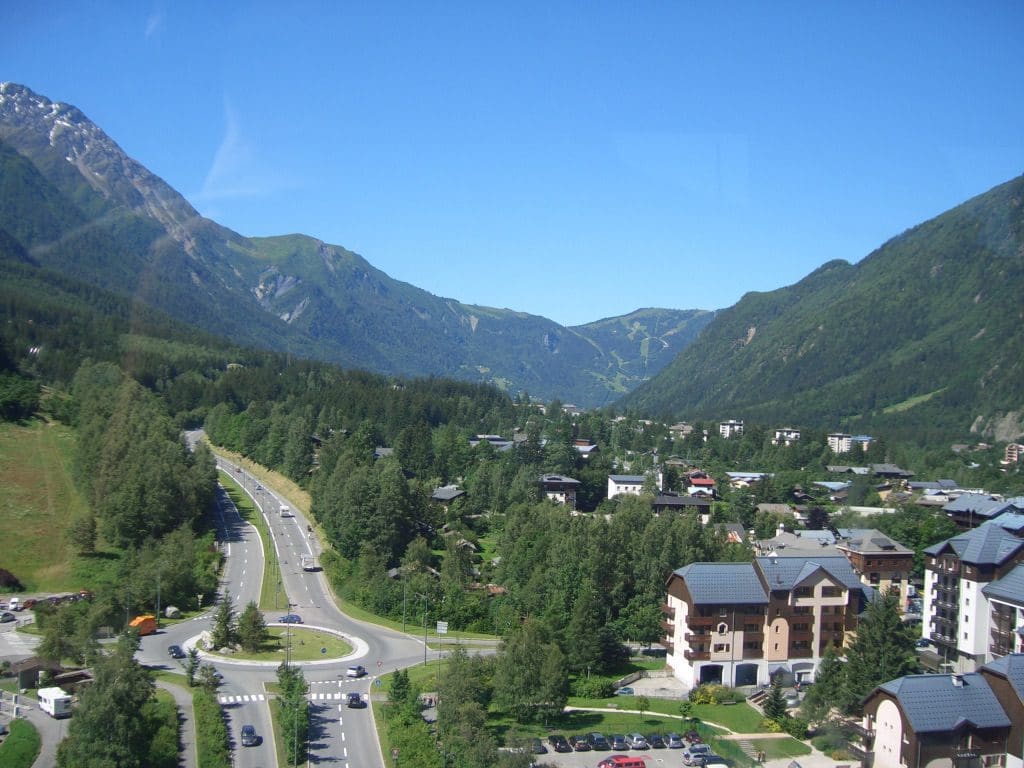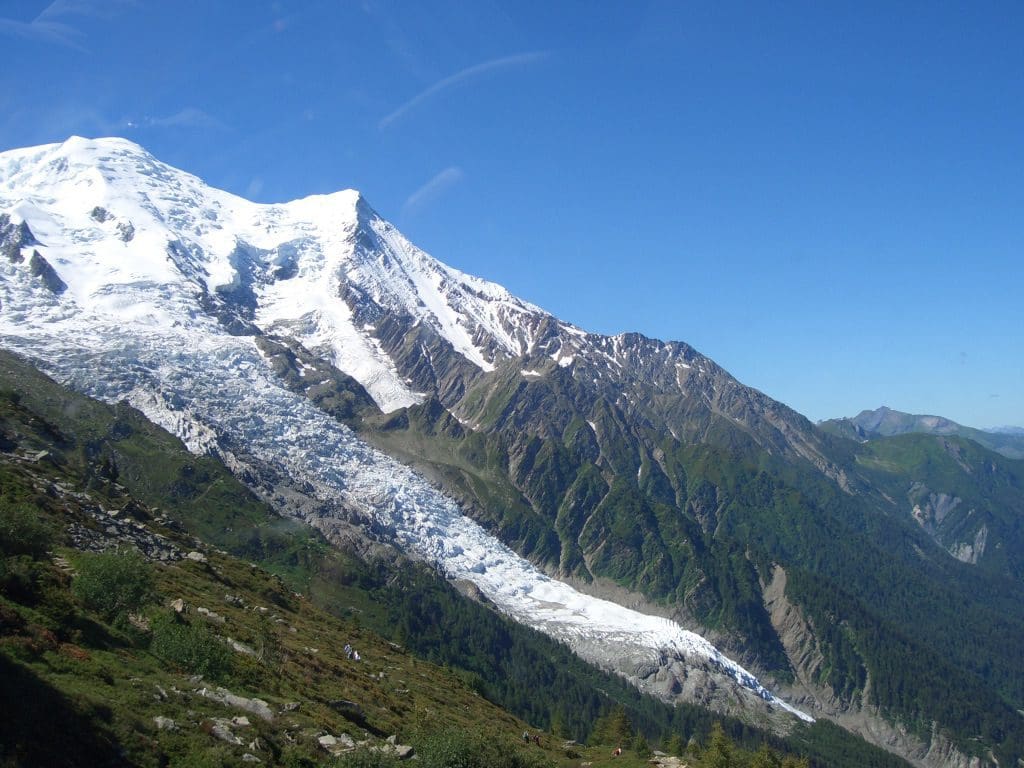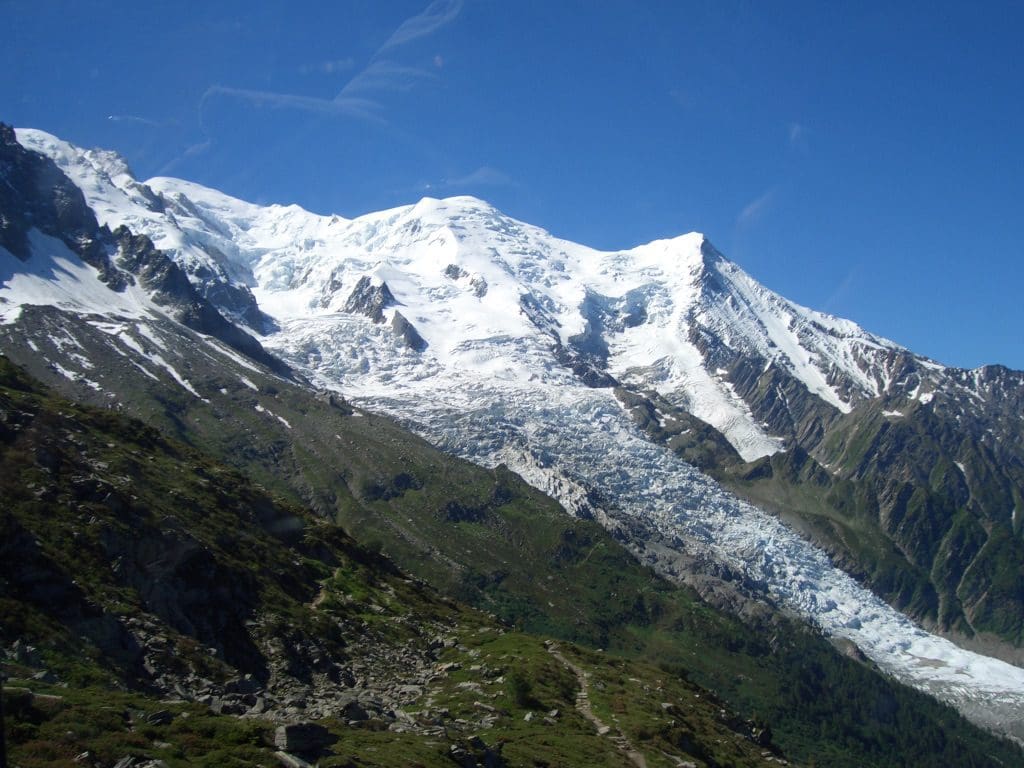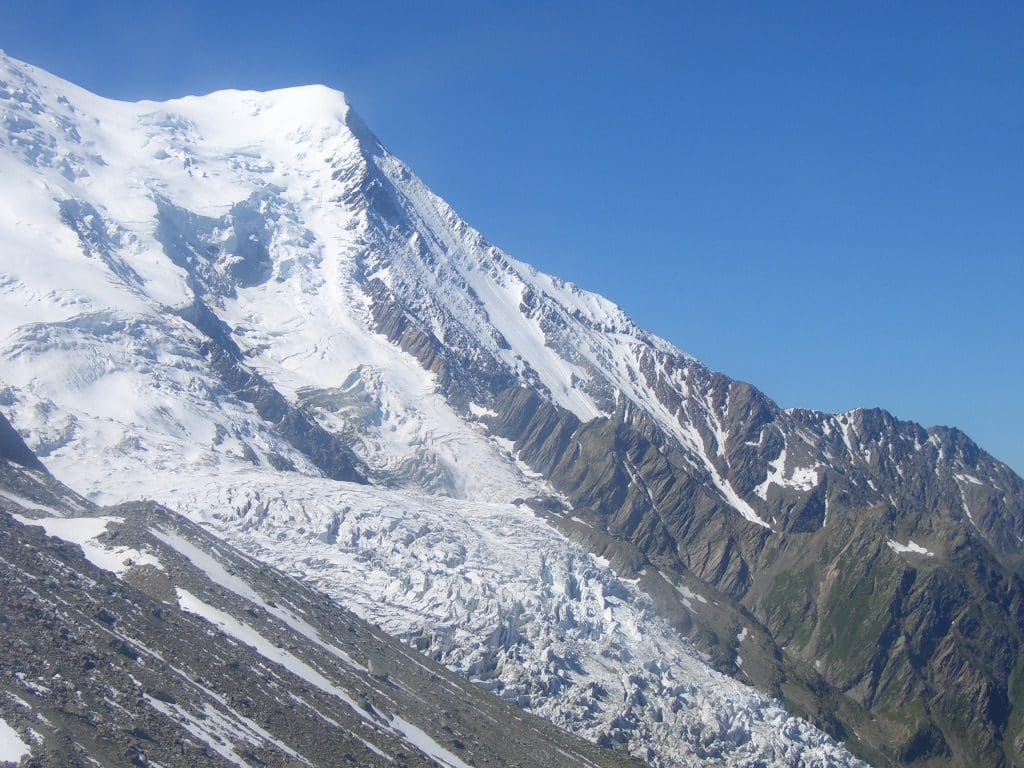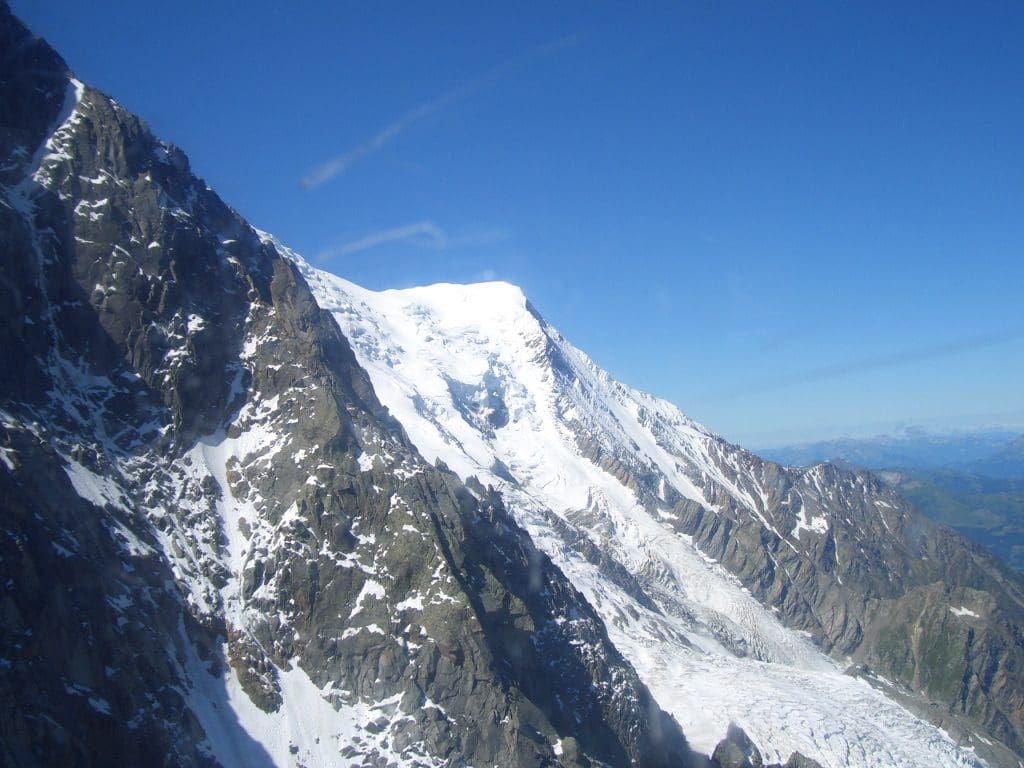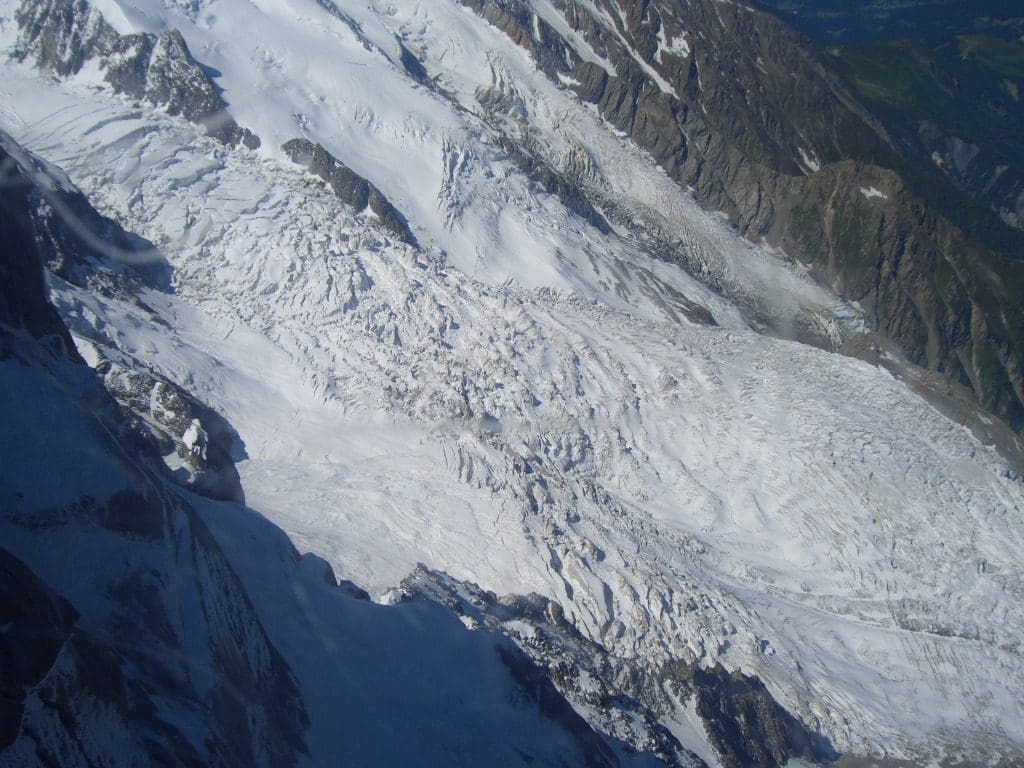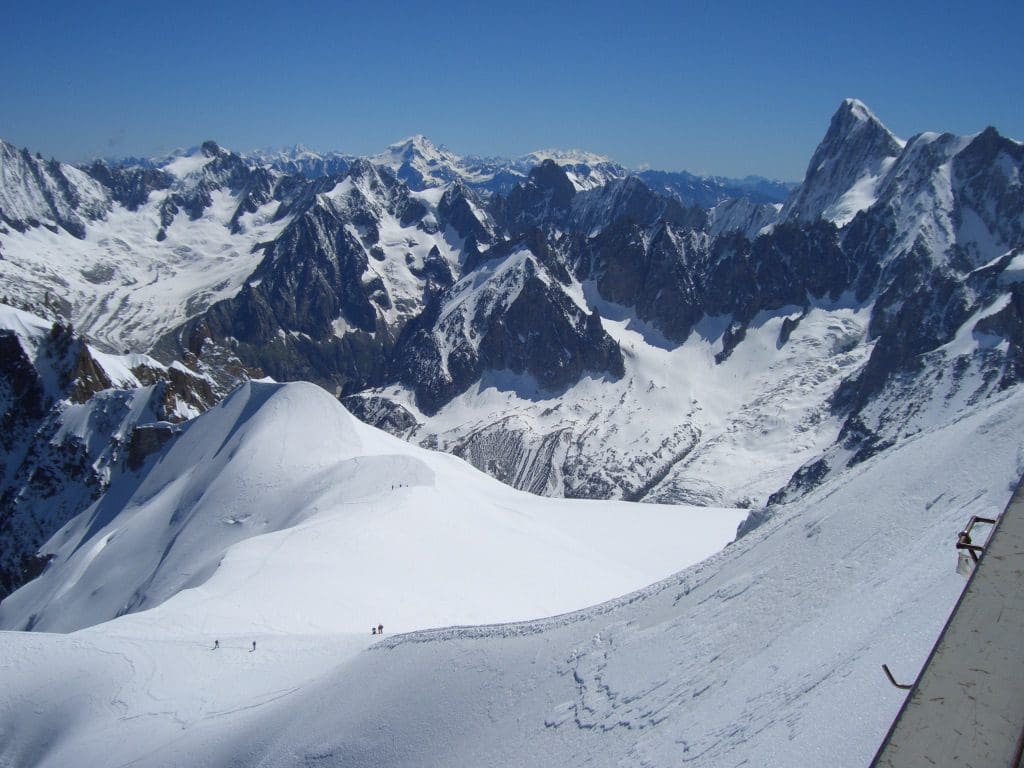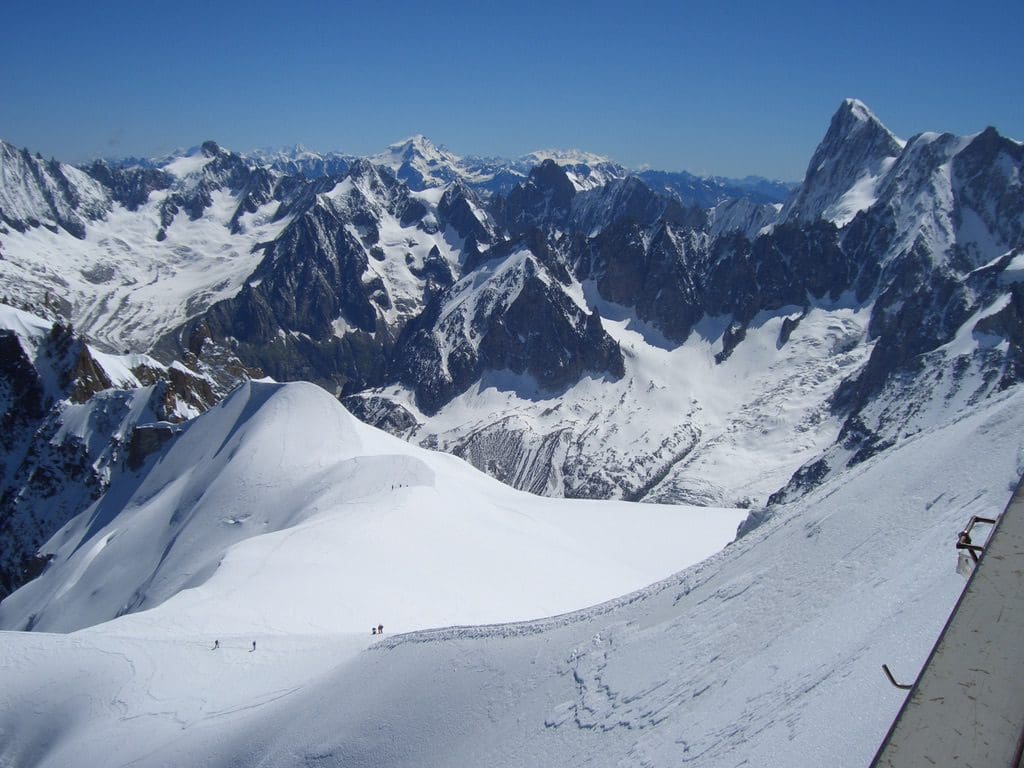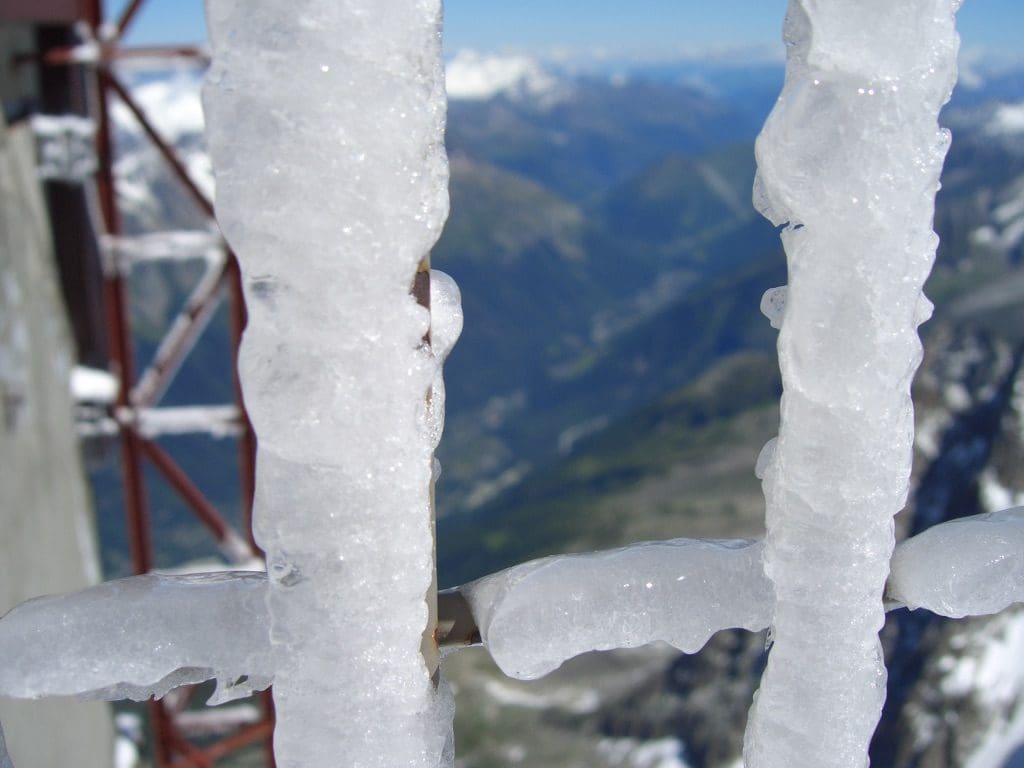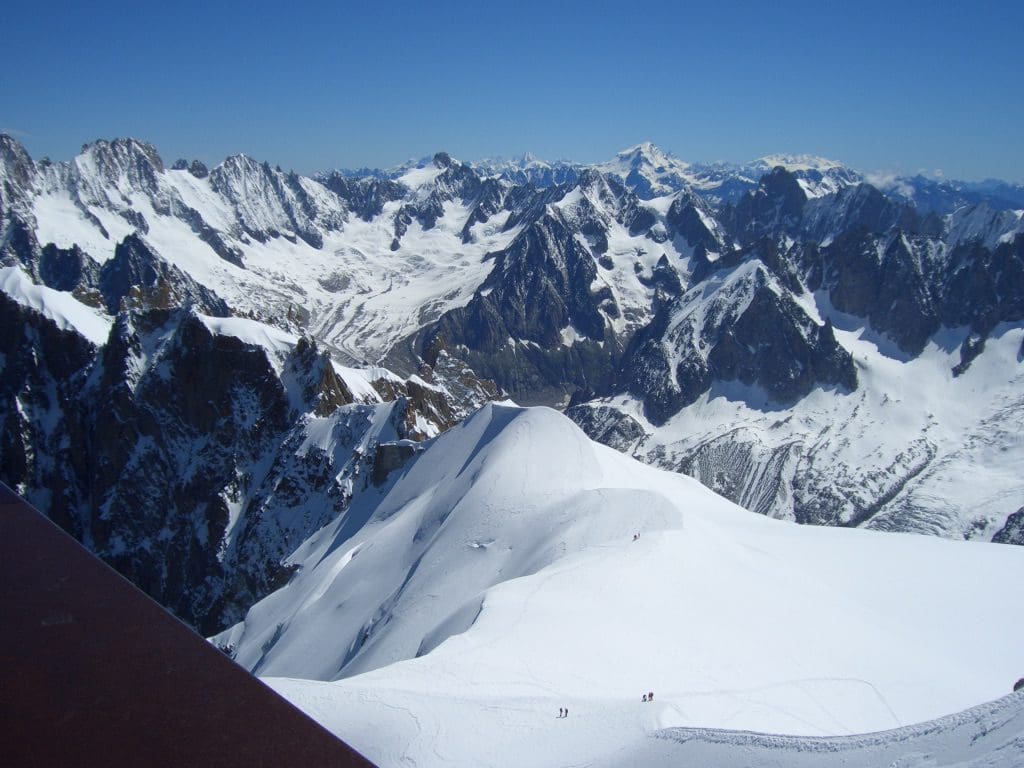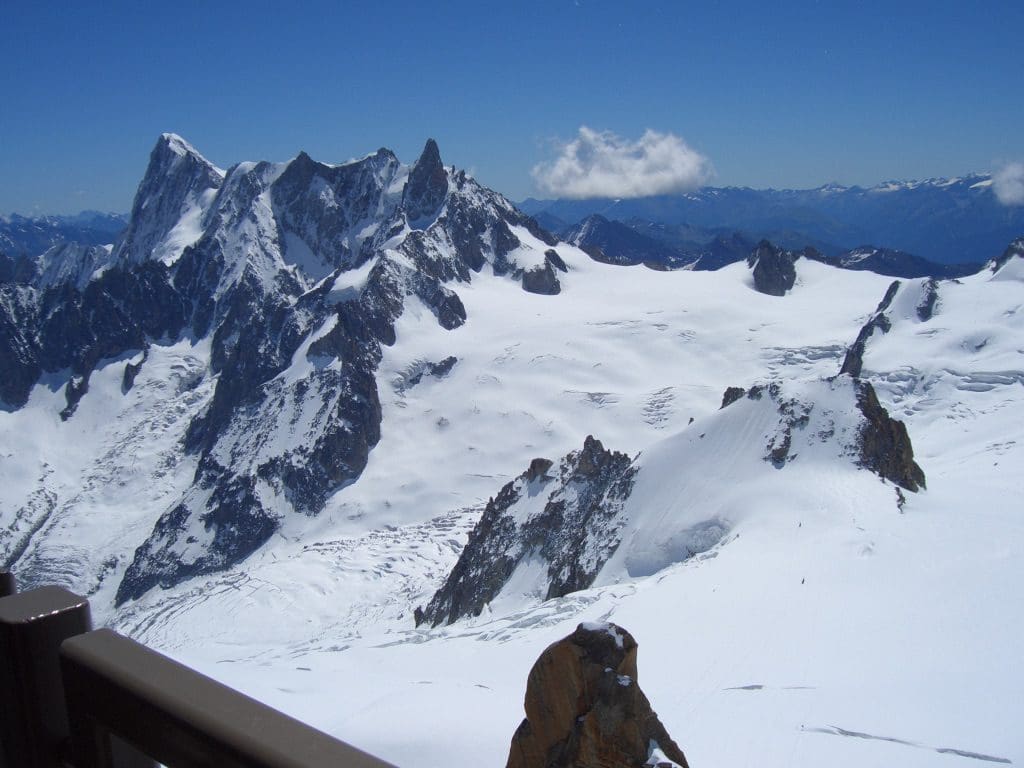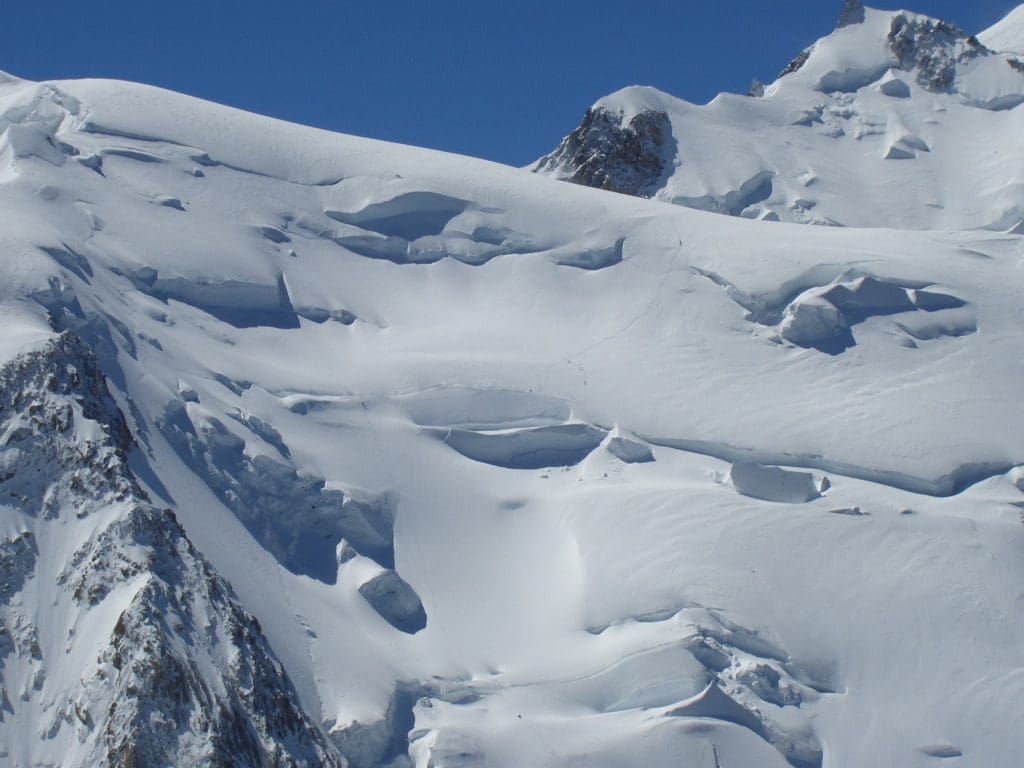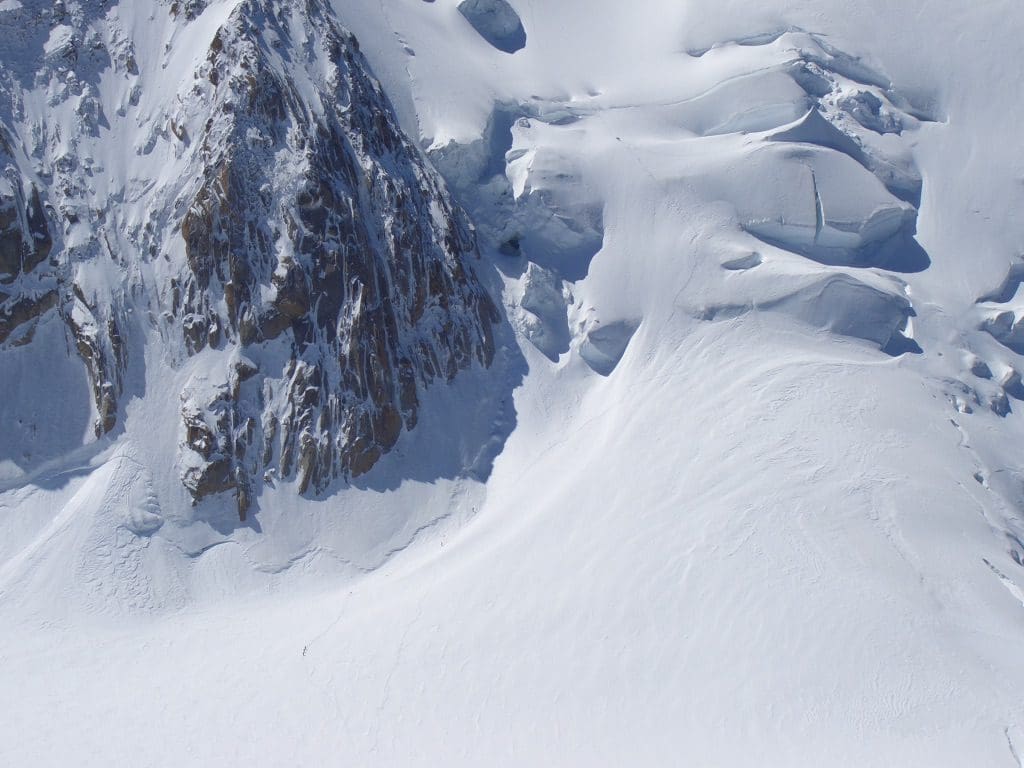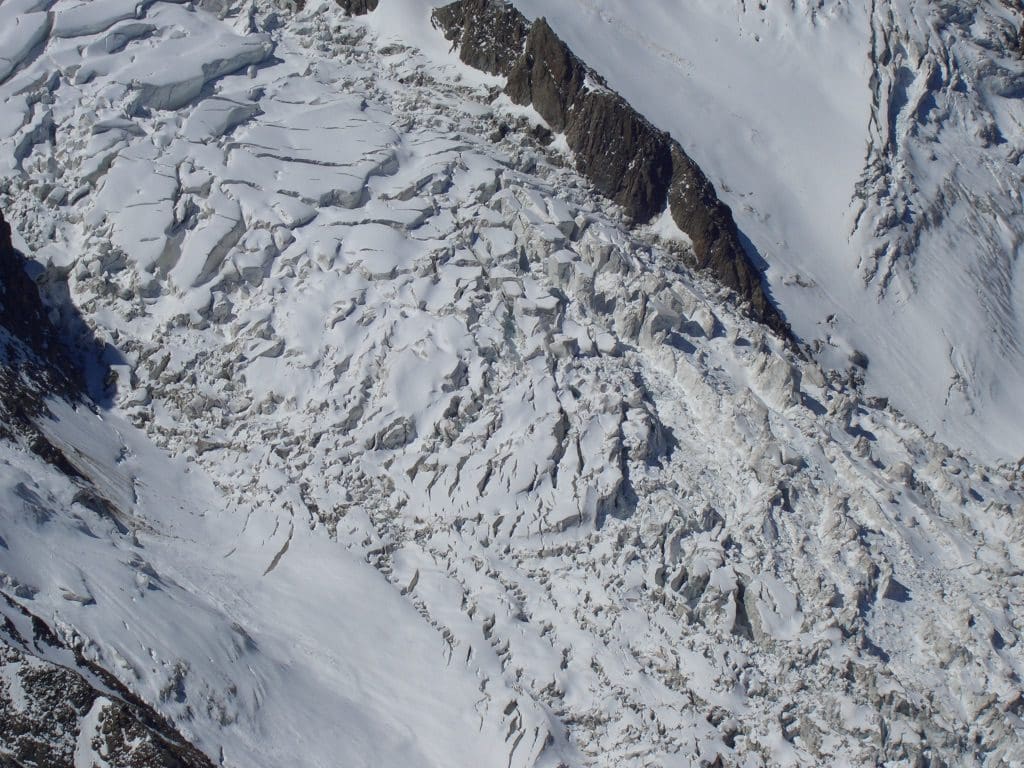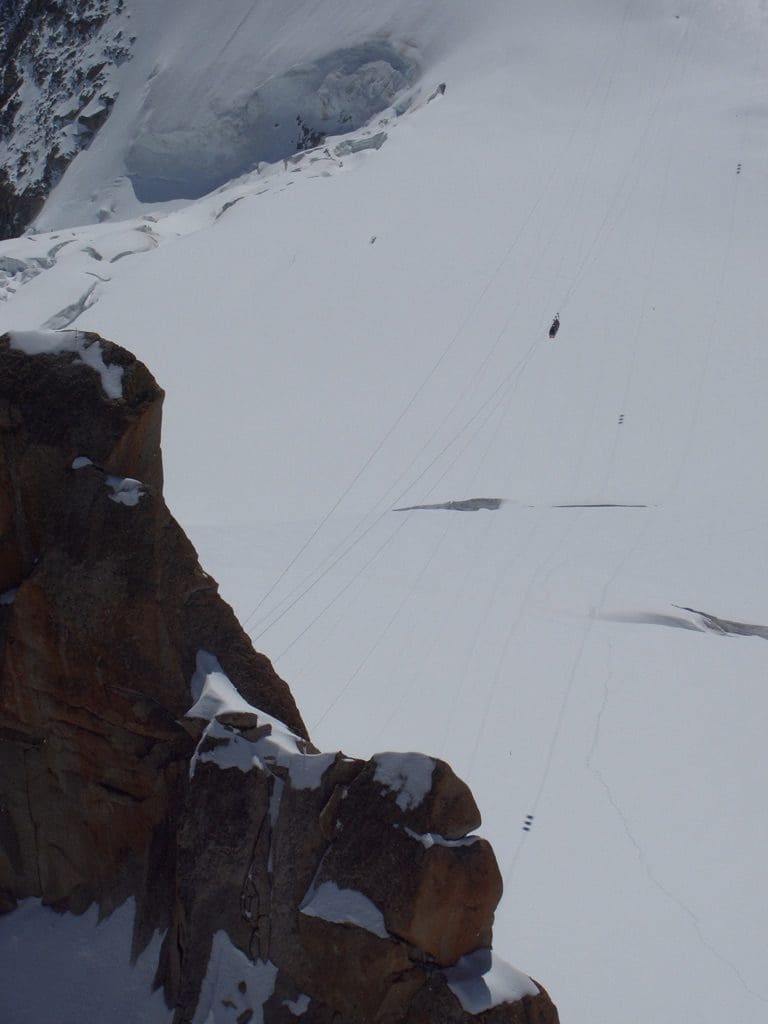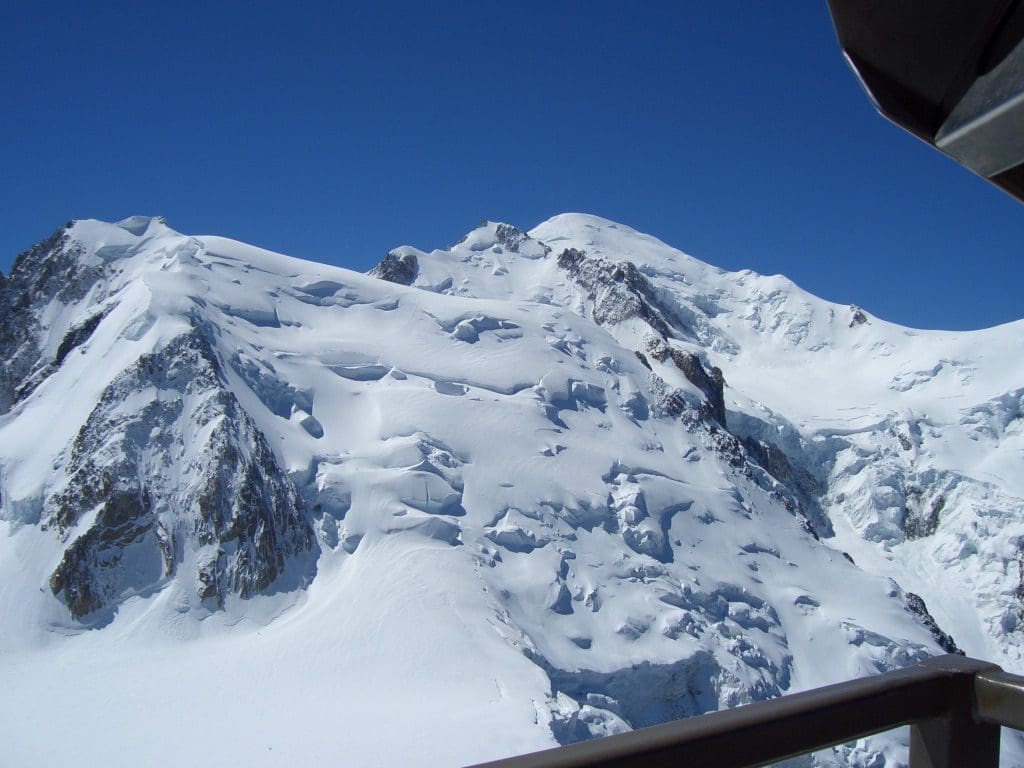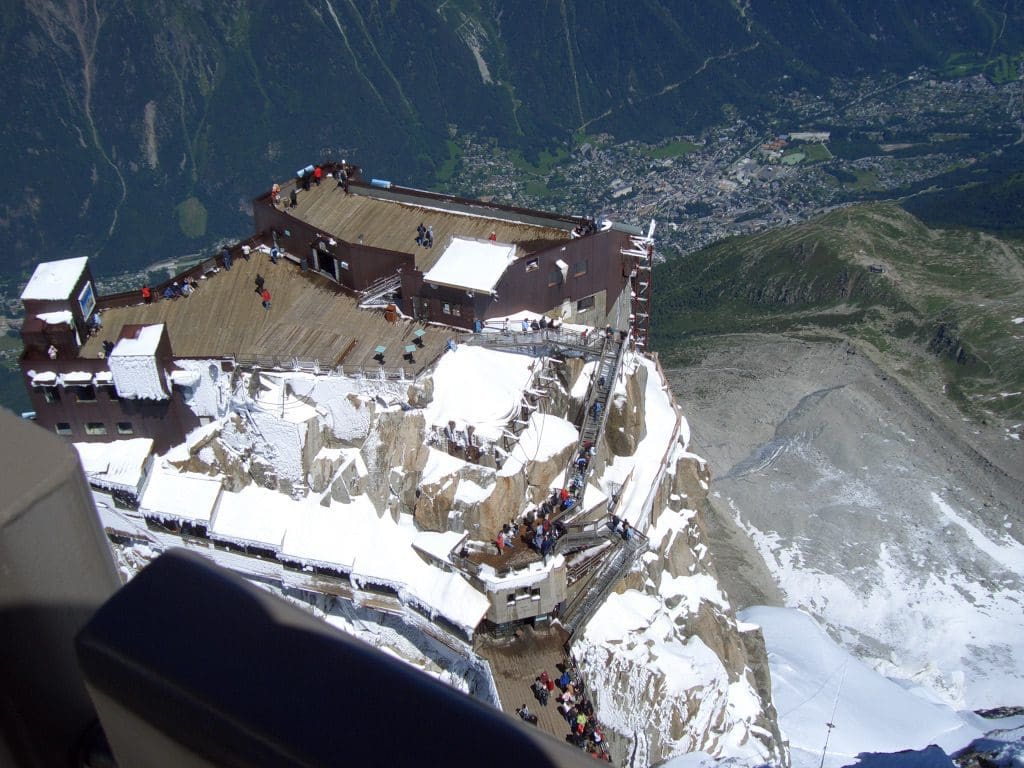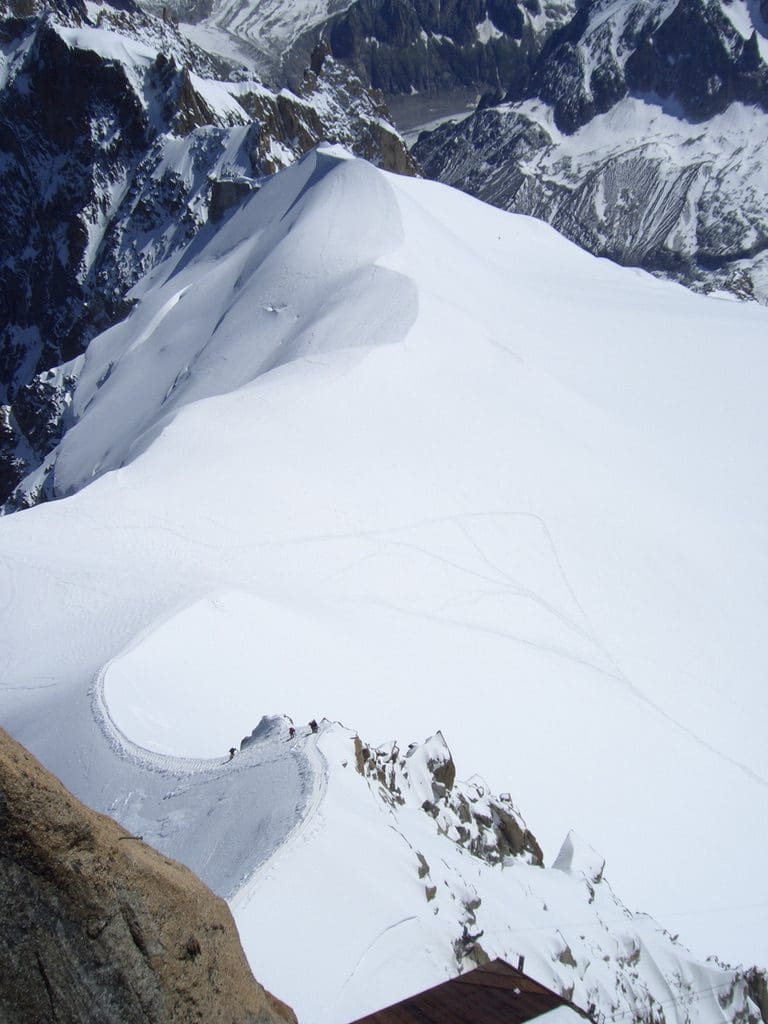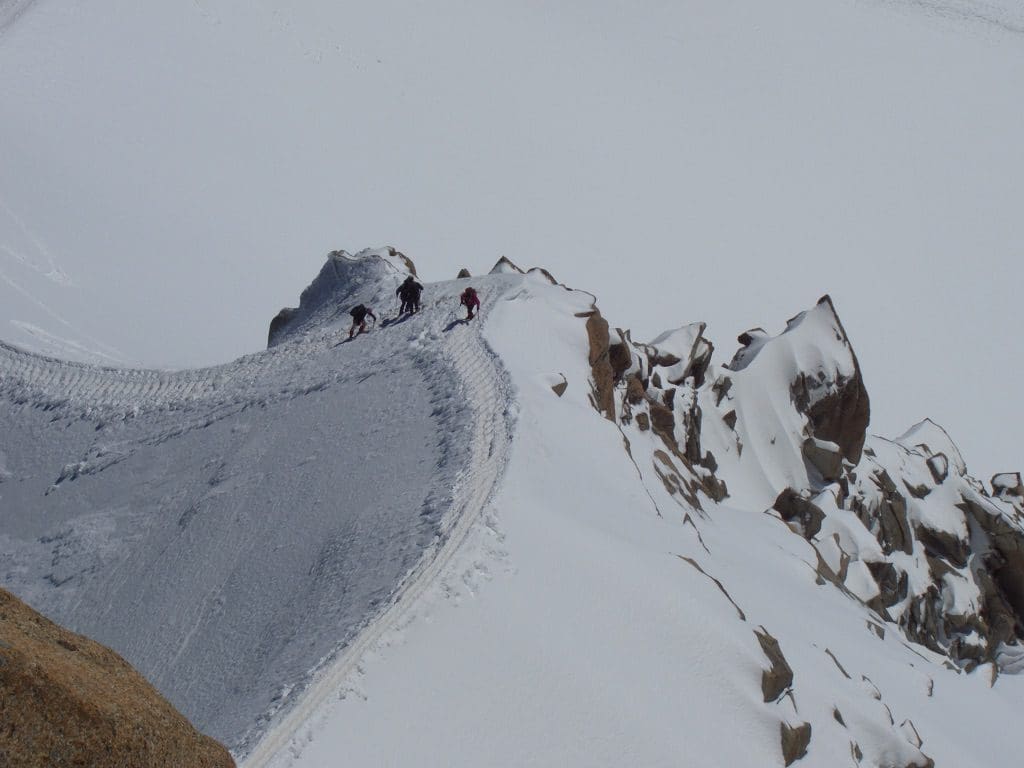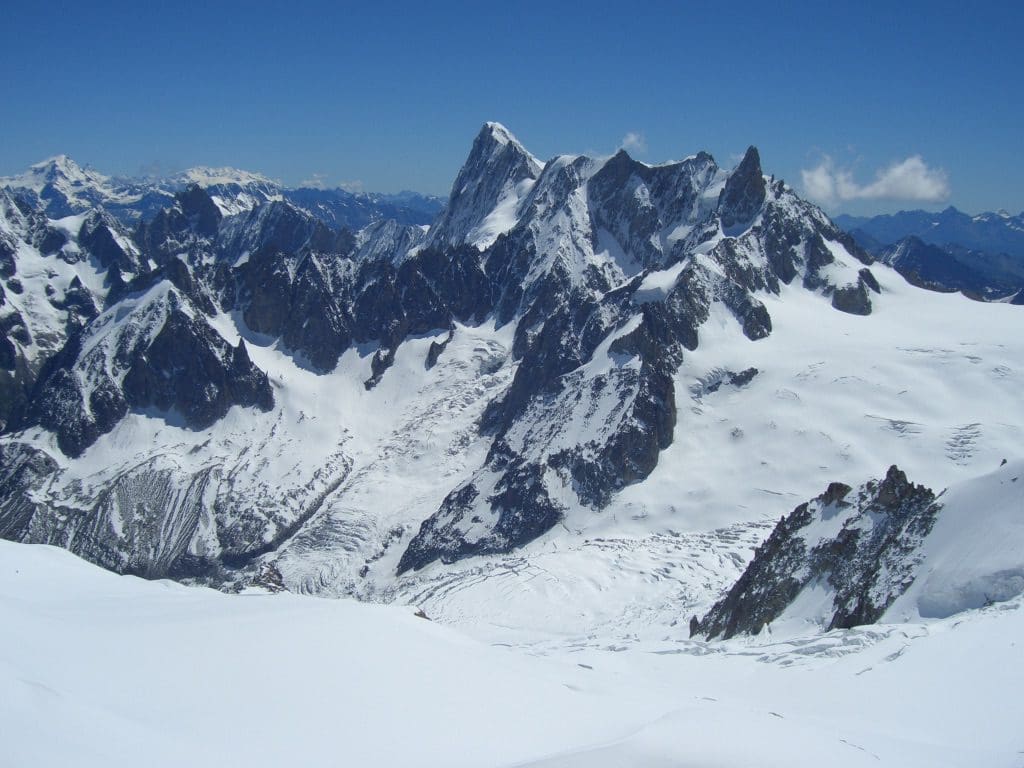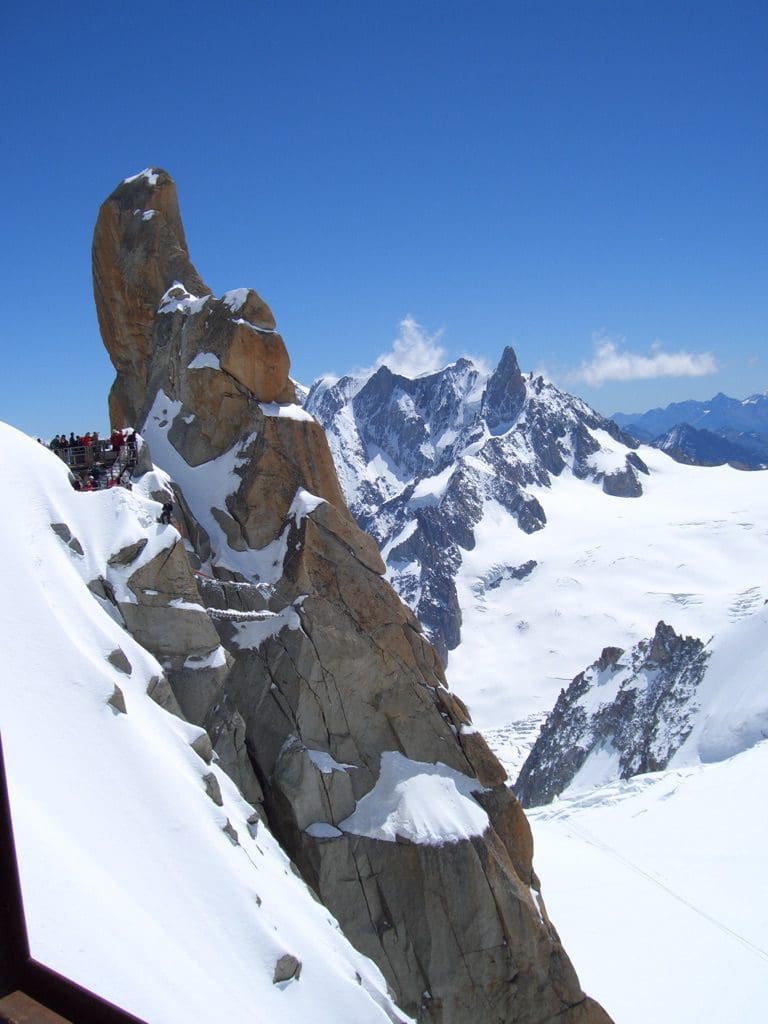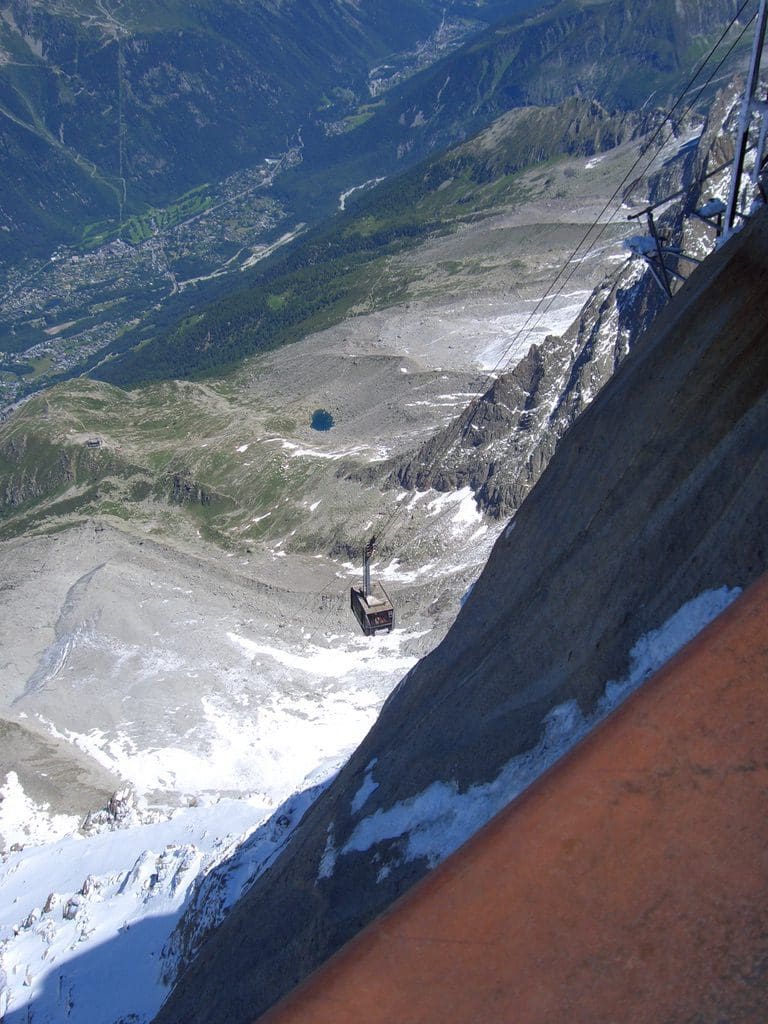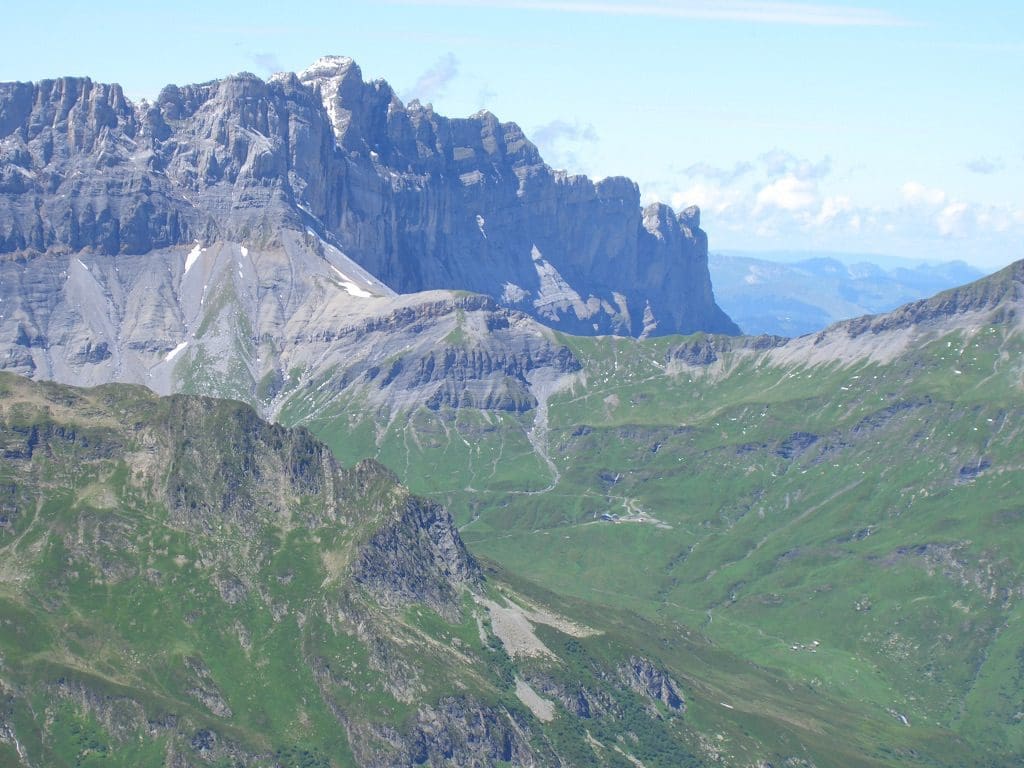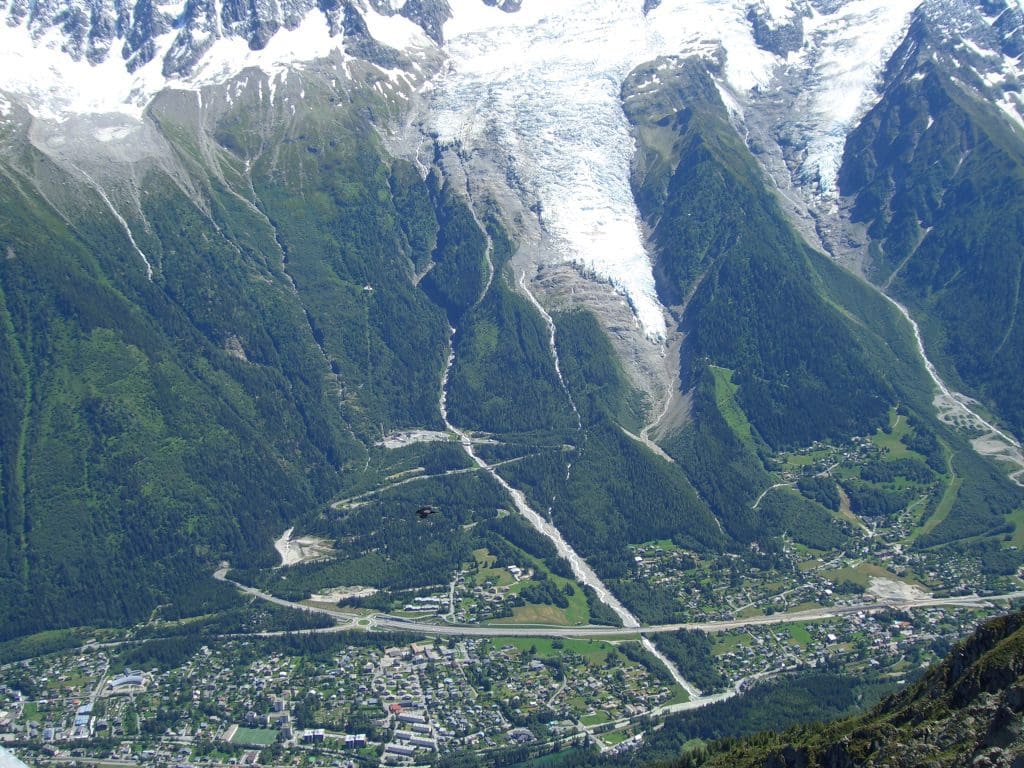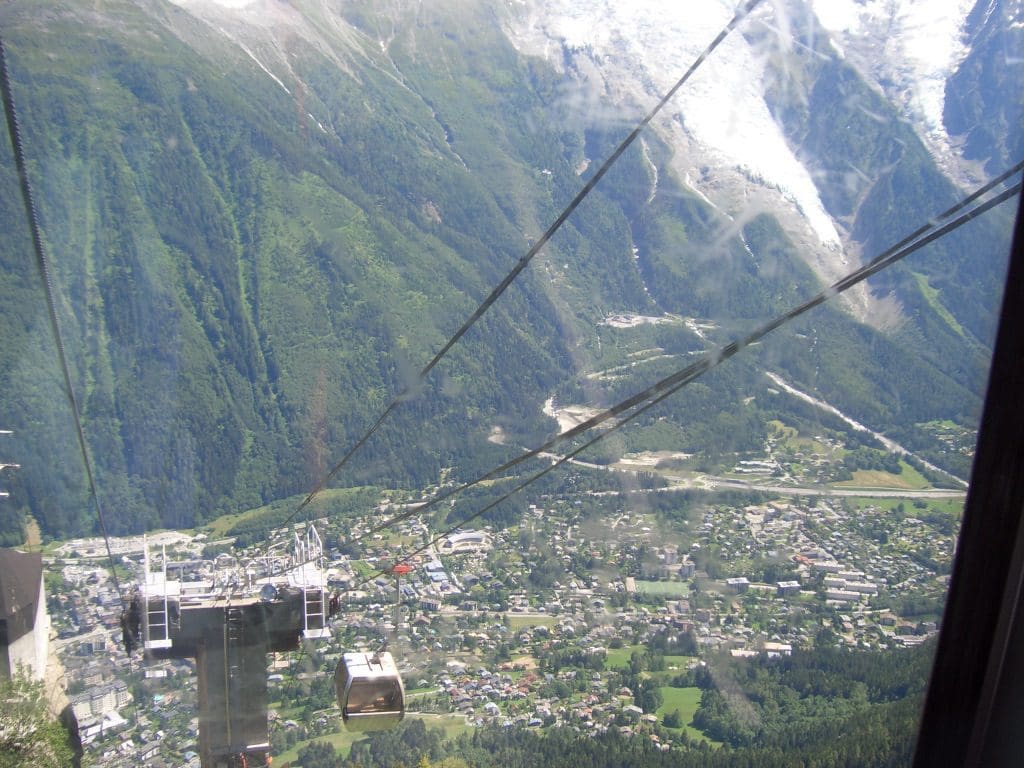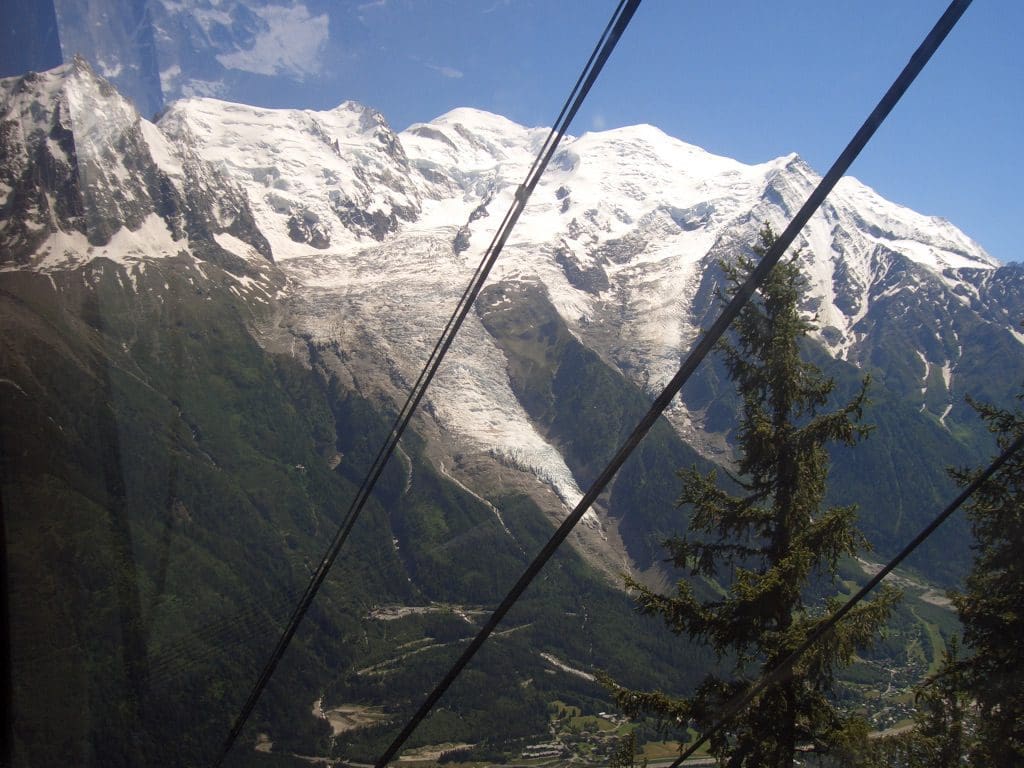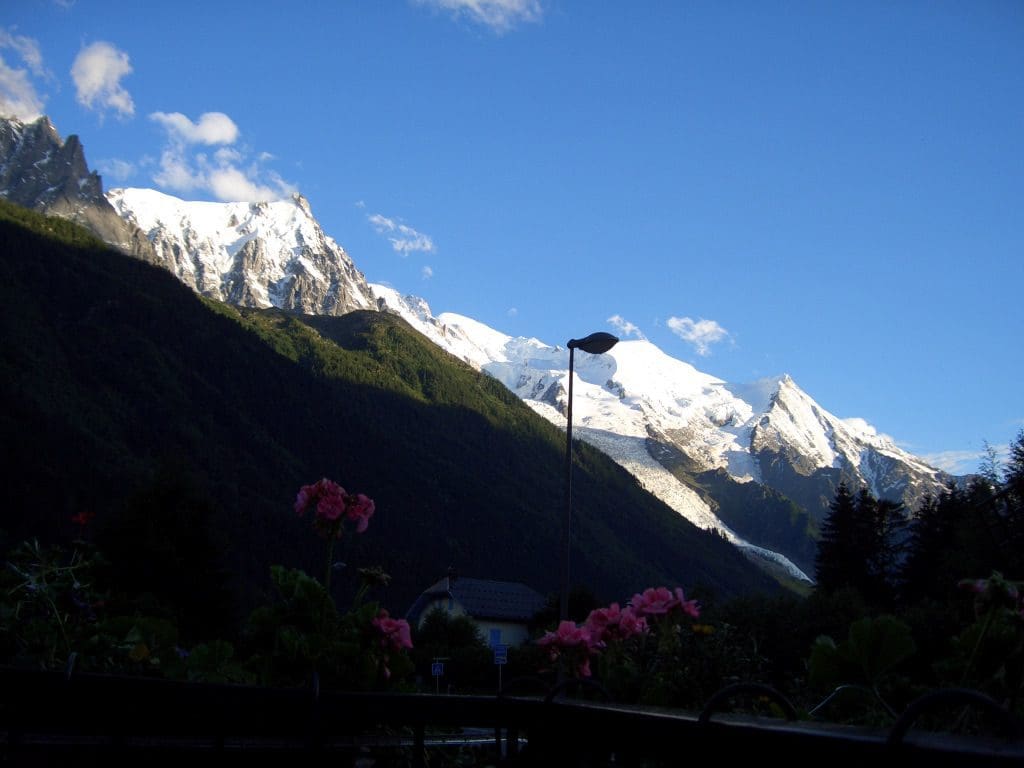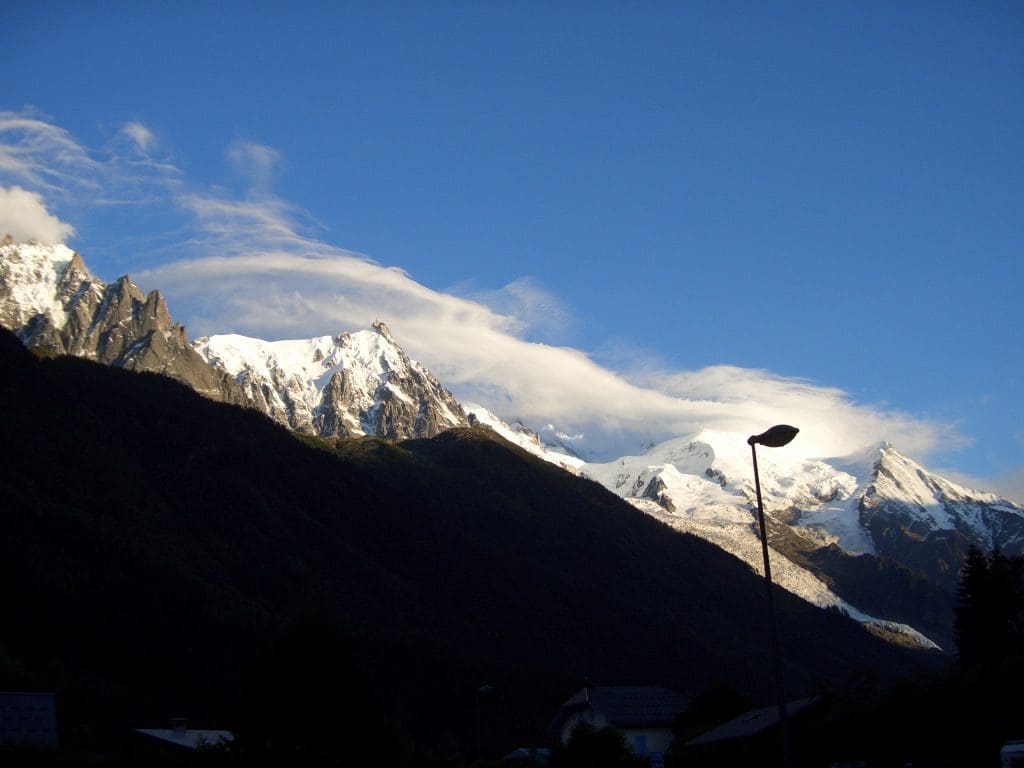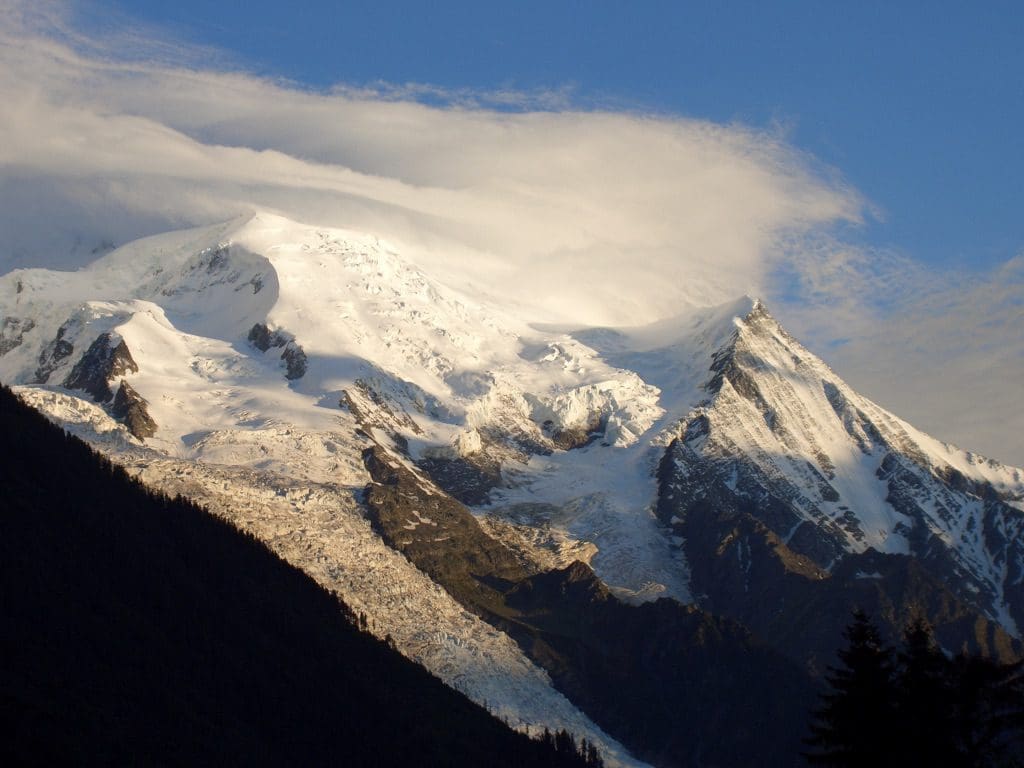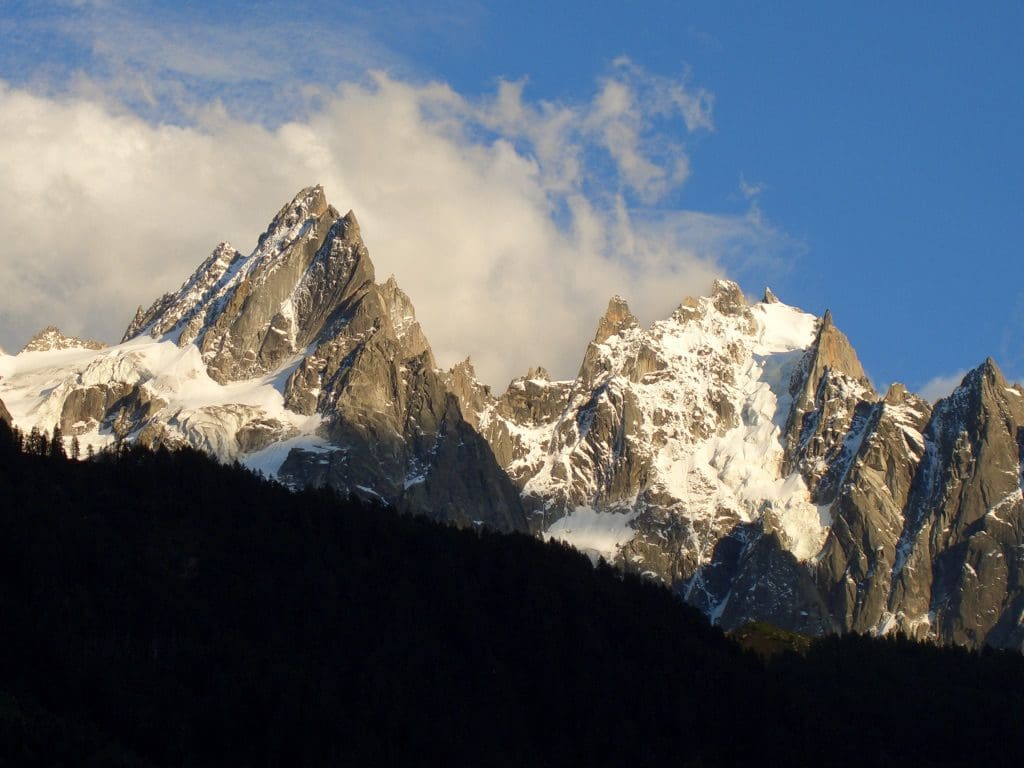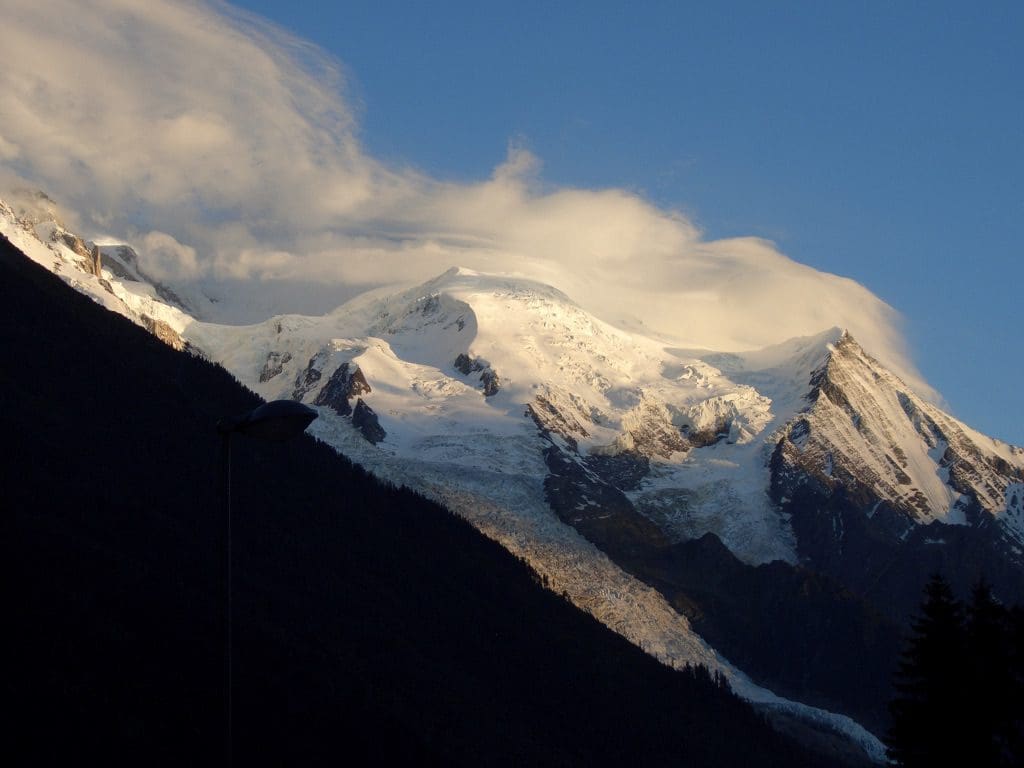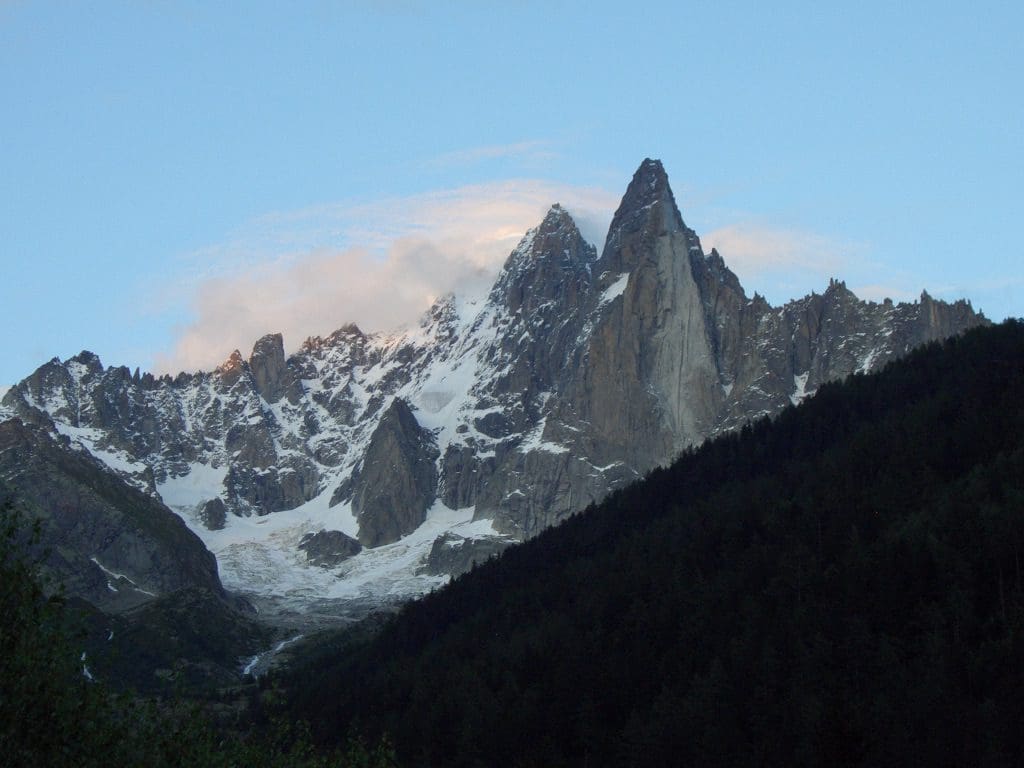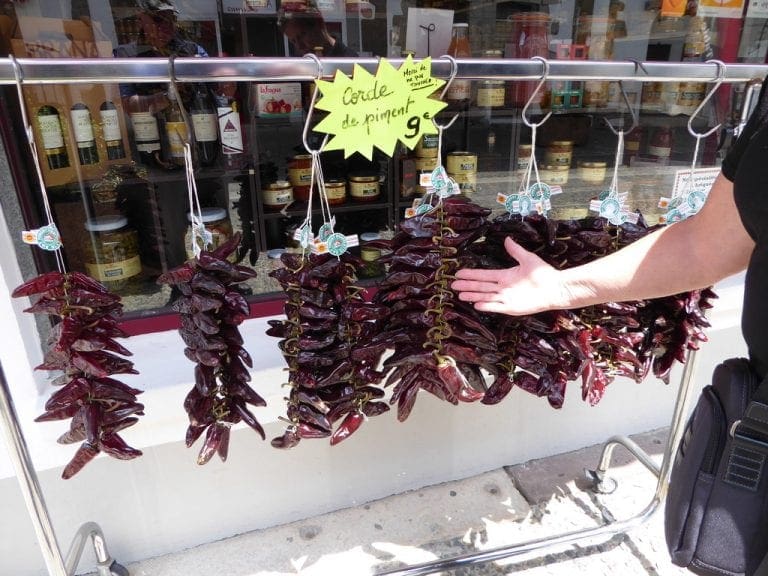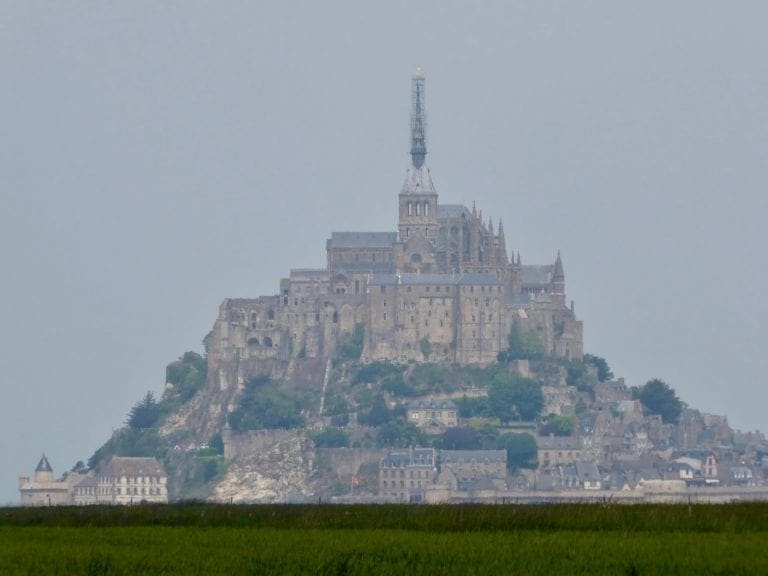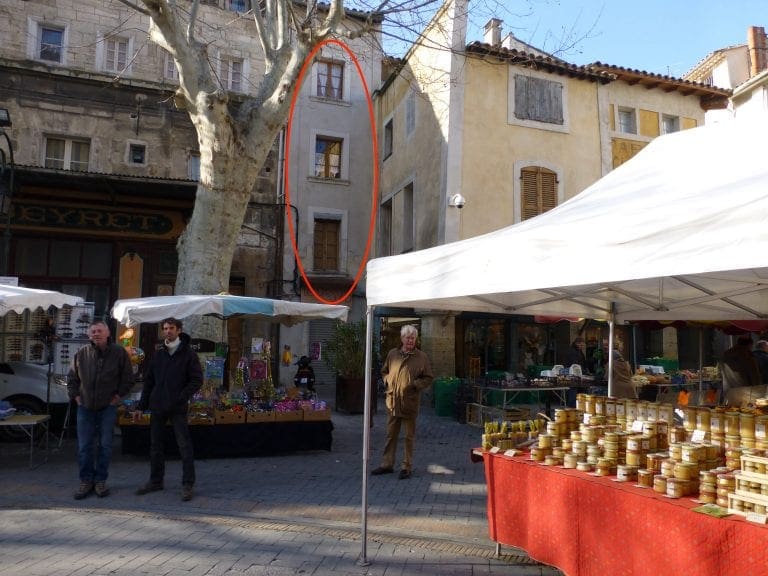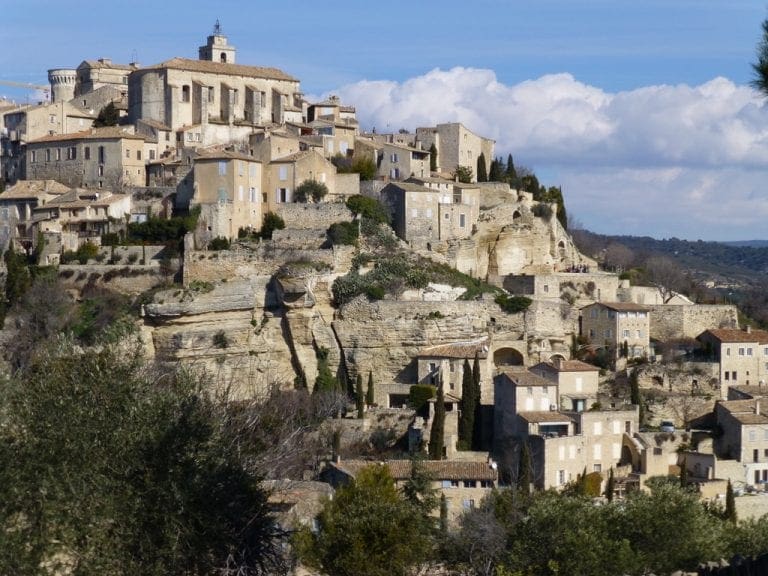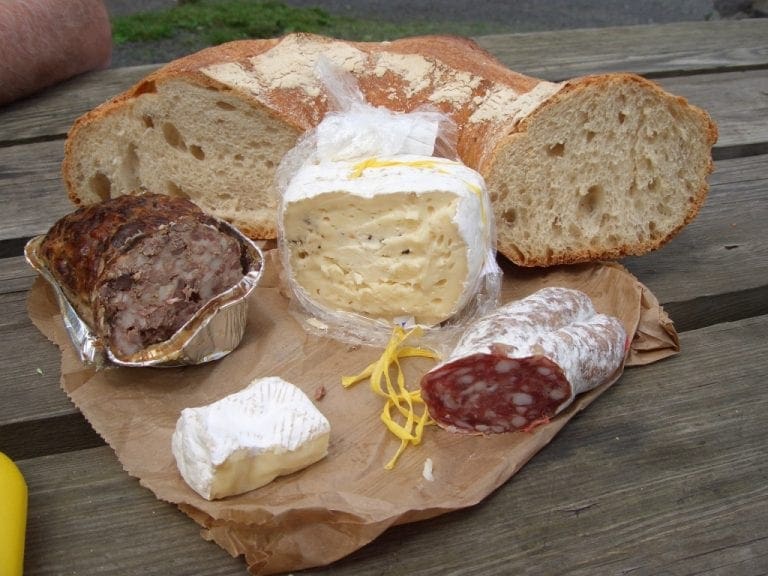Briancon, Chamonix
4/7 We were moving on today so dropped into town before hitting the road for a loaf of bread and what ever I could find. It seemed even quieter than normal until I walked out to the square. It was market day in Castellane. – food produce only – fish, dried and ground herbs and spices (sold by the decilitre for all the Mathematicians), several olive stalls, olive oil with herbs added, balsamic vinegar with herbs and berries added, mustard with herbs/berries added, the local farmers had a charcutiere which looked amazing, cheese, biscuits, lollies, wine, fresh fruit and veges (bought some figs that had been picked yesterday, ripe off the tree – ate them for lunch along with other goodies near a mountain stream next to the road.) (We had huge trouble remembering the word ‘balsamic’ in the paragraph above. Geoff wrote ‘basmanti’ first and we could not shift it. Don’t you hate that?)
We drove to Briancon. A complete change of country along the way. We began, at Castellane, in folded limestone (ie sedimentary rocks), drove up the ‘route Napoleon’ and within 100 km the rocks had become metamorphic (slates and schist). The vegetation had also changed in response to the rocks and a wetter higher climate. A strong wind had come up (Mistral) and was constantly blowing quite strongly, also cooler . The girl kept finding short cuts up over ridges that would have cut 30 seconds off the trip if they had been flat. However, because of the very windy roads in 1st and 2nd gear, her short cuts added 1 ½ hours. Very beautiful and worth all the detours. Briancon is windy with the Mistral. Overnight it got to 3 C.
For dinner, we went into the old fortified part of Briancon and had a Raclette at an excellent little restaurant – (le pied de la gougille). We had had raclette once before in Canada. Using a cheese melter at the table a special cheese is melted over a variety of food – boiled potatoes, cold meats, pickled onions, gherkins etc. After dinner and back at the campground – micro bats catching insects in the fading light.
5/7 A late start (the wind had gone and it is warm and delightful) and off to Briancon to walk around the old town. Just as we got there, a major celebration was held in the main square. The town garrison was all lined up, medals were given out, speeches made by a Colonel and a General. We understood one word in a hundred. Very interesting. One contingent (about 100 men and women) in camouflage gear and kepis, another lot in blue with black berets, a third in white with hoods and white berets, fourth lot in white with climbing ropes and climbing axes (commandos). The ceremonies lasted an hour.
After that, we went for our walk around the old town. Briancon is at the meeting of 5 huge valleys that run through the Alps. Italy is just a few km away. Geneva is just up the road. This was a major route through the Alps in Roman times. Briancon is supposedly the highest town in Europe at 1390m (not sure what makes a town). It is in 2 parts – an old city with a very strongly fortified wall, drawbridge, moat and portcullis. The fortifications were specially built and in 1815 were put to the test when the town withstood a 3 month siege from the Austro – somebody. The old town has one main street that has a water drain down the middle (known locally as the gargoyle) and goes up at a steep angle so it is mainly wide steps. It is just wide enough to fit a delivery van. The rest of the ‘streets’ are alleys and stairways. They are trying to get the whole thing recognised as a UNESCO heritage site.
On 17 July, the Tour has a stage finish here. We intend to see that stage, so we will be back in the area in 12 days time.
We went back to our favourite restaurant (called ‘At the foot of the gargoyle’ because it is at …). This time we had the potato bake – tartiflette – sliced potato with a little bacon and herbs and covered in fondue melting cheese. Superb.
6/7 We drove over a full day of the Tour. They must be absolutely mad. We did drive in the opposite direction to that which will be taken on 17/7. However, what we have seen on TV gave no indication of the extent and steepness of the climb. We drove from Briancon up the Col du Galibier and the Col du Telegraph. These are exceptionally steep and gruelling bits of road. Then on to Col de l’Iseran down to the start point for the stage at Val d’Isere. Very steep and narrow roads. There had been recent snow from the winds a few days ago. The outside temp was down to 8C with a 25+ knot wind blowing. F*&$ing cold. The rider would be in a sweat on the ride up and then be in a blast of cold air at the top. No wonder they zip jerseys up for the descent. Beautiful scenery amongst glaciers and u-shaped valleys.
We continued along the road of the previous stage (Le Grand Bournard to Tignes) and went up the Col du Petit St Bernard. This has more wiggles than the ABC. The Tour goes up only part and we intend to find a spot on the side of the road to see them go past. Today, we continued to the top of the Col and crossed into Italy. Suddenly, the road signs disappeared. Italians don’t appear to believe that signposts are necessary. We did find our way so maybe they were sufficient (old mathematician joke).
The last part of the trip was through the Mont Blanc tunnel and back to France. The tunnel is more than 10 km long and since the fire in the tunnel a few years ago – 1999, they have introduced many safety regs. Speed between 50 and 70 km/hr. 150 metres between cars (to sets of blue lights). The toll was 30 euro. The tunnel almost exactly straight and flat. There was little traffic going our way but a huge queue going the other way. From there down to Chamonix and a delightful campground under a glacier.
7/7 A day of cable cars at Chamonix. Incredible views. We bought a two day pass that gets us on all lifts – 55 euro each. First we went up the high one that goes up close to the top of Mount Blanc – Aiguille du Midi. We lined up for 30 mins for tickets and then 50 mins for a car. They run every 10 mins and hold about 50 people. The journey to the top is on three stages and begins at the town of Chamonix at about 1450 metres. The first stage looks scary from the bottom but was not. It goes to 2317 meters. The second stage appears to be vertical for a while and goes to 3776 metres. (This was white knuckle stuff for Geoff). This cable car runs at 13 metres per second – ie 45 km/h – the two cars pass at about 90 km/h. There is then an elevator that goes up to a viewing platform at 3842 metres. The views were stunning. Mount Blanc is then just a short distance away. We have some quite good footage and shots – mainly of Geoff’s white knuckles hanging onto the railing. A beautiful day with almost no clouds. The climbers were out in droves. Several groups. Several actually climbing Mount Blanc. It was eerie to be on the viewing platform eyrie with all the climbers either setting out or returning from their climbs. It is possible to continue all the way over to Italy by way of cable cars, and there were quite a few Italians who had made the journey from the other side. It would be a fantastic day trip. As I (Geoff) type this I can see that viewing platform from the campground. There are a several very jagged peaks to the left with names like crocodile tooth and caiman tooth. Several glaciers come down from the Mount Blanc massive. (And the tunnel we were in yesterday goes straight under the lot.)
Down to the 2317 mid-station, ‘Plan de l’Aiguille’, for a spot of lunch – bread and cheese. It was too cold at the top to be outside too long. We had thermals and raincoats on. There was ice on most exposed surfaces.
We decided to use our passes and go up the cable car on the other side of the valley. This goes to only 2525 meters – in two stages. The first is a four seat gondola and the second is a cable car that runs almost horizontally – like a flying fox – to gain the last 500 metres. This flying fox was scary indeed. Geoff had wedged himself into a corner ready for the trip when a bunch of German cyclists arrived and demanded the bikes be put at the back. So we were near the doors. S#%t!!. The views again were spectacular. We had a good walk around the top – which in winter is the top of a ski run. Actually, the run down that bike riders took was not much steeper than our favourite run in the Snowies – Bob’s Ridge. Here was longer and they had the distinct advantage of not having to ride up the thing first.
Writing this sitting in the campground ‘Mer de Glace’. This is an excellent campground with excellent facilities and free wifi. Looking up, we have the snow-covered peaks of the Mount Blanc range on one side with quite good views of glaciers and jagged peaks. The other side is almost as steep and high but does not have the snow. It is the only campground we have been in where people wander around with video cameras – even filming the amenities block. What makes it so good? Certainly friendly and helpful staff (this is the only place where we have had a guided tour), they are very well organised (we were given free bus passes for the valley), the views help, it has enough shade and not too hot (although the temp is 30C), the pitches for tents etc and not on top of each other and are big enough.
Geoff has finally given up on the old walking poles (that were held together with bits of fencing wire). Two new Leki poles were purchased today – two poles for less than the price of one pole back in Oz or NZ.
Helen takes over- we got to a place today that I have seen so often on TV and dreamed of getting to some day. Today it happened under a clear blue cloudless sky (it has been raining here for the past two weeks). I could not help but do a little jig on one of the viewing platforms where glaciers plunged down to the valley below – I don’t have the same sweaty fear of heights that Geoff has – he was taking some very slow deep breaths today but announced later that he was glad to have been persuaded to go to the top. This place is spectacular. In another part of the world each valley would be a tourist attraction. Here, you are overwhelmed with valley after valley and jagged peak after peak and glacier after glacier. It would be very easy to spend the day sitting in one place watching the changing colours, shadows and clouds over one section of the valley with majestic peaks in the background.
Our campground is between ‘Mer de Glace’ (the longest glacier in Europe) and Mt Blanc (the highest mountain in Europe) so as we sit here at 9.40pm I can glance every now and again and see both of them.
(Just as Helen was typing the above, our neighbourly poms came over for a chat. She teaches French at Uni and he is a semi-retired stress-engineer from Airbus. He told a few stories about Airbus wings and having to use applied maths to make minor corrections when things go wrong: one wing had a big chunk ripped out of it when the lorry driver failed to get it through a narrow street; another wing was dropped (that wing then needed to be re-stressed); sometime components of the wing are made a little too thin (the stress-engineers have to work out how to correct it); another common problem is for the chaps on the factory floor to drill holes where no holes were planned (this needs a good going over of the original calcs and computer modelling). ‘Very interesting work’, he said.)
Geoff finished reading Seth’s ‘A Suitable Boy’, highly recommended book of India in early 1950’s. Full of 3-d characters well created with a few words. People to recognise and wonder what they are doing now. Extremely good.
8/7 A day of disappointments. We were certainly lucky with the weather yesterday. Not so lucky today. However, we began, again, with a flat battery. Very flat this time. A push was not sufficient. Jumper leads got us started, but before they were produced by a friendly Dutchman, we had begun the process of ringing Citroen who, despite hearing that the car was running, insisted on sending a tow truck. Ah well. The annoying thing is that we have no idea why the battery is going flat. No lights etc on. It was raining fairly solidly by now. After the tow truck driver had left with Gaelic shrugs, we decided to go up the Montenvers rack railway. This goes up from Chamonix to a point over looking the ‘Mer de Glace’ glacier. We had planned to walk from there up 500 metres to Plan de l’Aiguille (the halfway point from yesterday). This walk was off because of the rain. However, we might see some views. Not. It was raining very heavily up there and we huddled under a shelter with hoards of climbers who had been out on the glacier and had come back soaking wet. A very packed train going back. The car started so we had a look at the map and decided that a trip up the ‘Grands Montets’ cable car to 3275 m would get us at least a good ride. This was to be in two stages – the first to 1972 m. Unfortunately, the second (biggest) stage was shut so we could not go to the top.
Helen was caught short and needed a loo stop at the mid-station, and had a nightmare visit to an automatic dunny. Helen – First of all it was difficult to find, down two flights of stairs into the bowels of the mountain. I was impressed as it was very clean and I noticed that it had paper. Probably nobody else was persistent enough to find it. There were lots of signs about saving the environment/electricity and I noticed that the main outside light came on as I walked through the door. The light for the cubicle came on when you opened the door and the signs/pictures on the door indicated that when I locked the door the light would stay on. All went well for a few seconds and I was enjoying a very successful trip to the loo when I was plunged into darkness (despite the door being locked). I got up to fiddle with the lock– the loo flushed – a strange noise in pitch black – the door handle could not be reached (even by foot) from the pedestal so I spent the remainder of my visit planning attacks on the door lock and judging where the paper was, accompanied by regular flushings. Leaving the door open was not a solution as the light to the entry section had now gone out. I had visions of being locked in there and being found as a skeleton by someone cleaning the loo in preparation for winter.
There were a few marmots at the mid-station and these things make a lot of noise – very loud whistles. Back to the bottom. It was 4:30pm so no more lifts for the day. We had a kip. About time too. To add to her woes, Helen’s air-mattress is leaking again and is going down slowly during the night. Bugger.
We went back to the local pizza place for dinner – same pizzas as yesterday, similar crowd of locals watching the sports channel on the TV. We saw clip after clip of Robbie McKewan winning stage 1 of the Tour.
Morning of 9/7. We had a night of torrential rain and minor local flooding in the campground – several large thunderstorm cells swept across the valley every half hour or so – thunder and lightening. We were not actually wet in the tent, but is was a close run thing. Helen – my bloody air mattress fully deflated during the night. Spent hours trying not to touch the side of the tent which was very wet and spent the rest of the time fighting with the sleeping bag which successfully tied itself into a knot. Not happy Jan! Walking through ankle deep cold water in the morning and having breakfast and coffee huddled in the tent is not a pleasant thing. The cheery multilingual greetings on the way to the loo in the morning were almost non existent this morning with most faces looking a little worse for lack of sleep. Activity in the campground corresponds to periods of slight lulls in the rain. Most of the campground is packing up. Our Brit neighbours have been coming here for 25 years and this is the most rain they have seen at this time of the year. It has been raining for the past fortnight. We were exceptionally lucky to have had such good weather yesterday. They have had enough and are heading home tomorrow. The lady and I had a whinge session yesterday afternoon. I was telling her about my automatic loo experience – she had just put on a clean pair of pants to go shopping, was trying on another pair of pants when she realised that the cubicle had a certain doggy-doo smell. Yep! She had stepped in the proverbial and now had it not only down the leg of the clean pair but also over the pair she intended to buy. Some days things can get just a bit too much!
